November 28, 2008
The Tales of Hoffmann at Covent Garden
Hickox, who died suddenly on Sunday, had conducted the 2004 revival of this opera, the production in which Rolando Villazón created a sensation in the title role and instantly became a household name.
Returning to the role, one which is a gift to such a versatile and committed character player, Villazón seemed older and wiser: more mature in his interpretation, instantly establishing his presence with the inebriate bluster of the Prologue’s Kleinzach song but equally comfortable with the nostalgic reveries of the Epilogue; and more astute in his pacing, somewhat restrained at the start but sensibly conserving his voice, relaxing and releasing a tone of warmth and ardour in the final scenes.
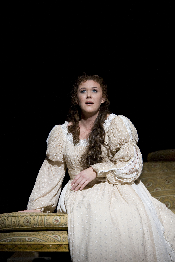 Katie Van Kooten as Antonia
Katie Van Kooten as Antonia
The production itself cannot be said to have made the same graceful
passage to maturity. The revival director, Christopher Cowell, has retained
the original Personenregie, with scarcely a fresh gesture. And, the
old sets looked tired and fussy, even tawdrily camp: sumptuously extravagant
and evocative of the opera’s various locations they may be, but the
accumulation of superfluous detail results in a rather dated literalism
— the ‘real’ gondola, the giant ‘floating’ bed
and miles of vermillion velvet hammer home their points but leave little room
for subtlety or imaginative nuance. Hoffmann’s original short stories
combine artistry and grotesquery, sparkling glitter and dark, ponderous
depths; yet this production seldom scratches beneath the surface, frequently
lapsing into gratuitous, pantomimic clichés.
This was a solid rather than a stunning cast. Of the female roles, Ekaterina Lekhina as Olympia was the audience favourite although this listener found her rather underwhelming; but she was jerkily, jitteringly suggestive of a soulless automaton, and certainly conquered the vocal peaks with confidence and accuracy of intonation, although there was little sense of continuity of line as she scaled the precipices. Katie van Kooten was an impressive Antonia, her radiant upper range strong and clear, although underneath the intonation was sometimes suspect and marred by unfocused note production. Christine Rice’s Guilietta was an intelligent, dramatically convincing performance, the powerful lower register of her resonant dark mezzo delightfully sensuous, perfectly conveying the courtesan’s allure. However, at times she overpowered Villazón in their duet textures, for while his high-lying lines were delivered with cleanness and panache, he was more subdued in the lower registers. Moreover, the erotic intertwining of the intended soprano and mezzo timbres in Guilietta’s duet with Niklausse, another mezzo, were diminished. Indeed, despite Rice’s intelligent portrayal, the Venetian act was the least successful; the assorted writhing couples languorously scattered about the opulent milieu evoked little genuine sensuality, and the whole lacked dramatic tension.
In the dual role of Niklausse/Muse, Kristine Jepson’s bright, animated tone projected well. Jepson has much stage confidence and natural ease; and she established an engaging relationship with Villazón which would have benefited from more sensitive and encouraging direction.
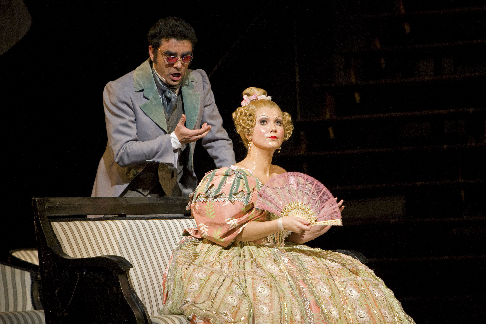 Rolando Villazón as Hoffmann and Ekaterina Lekhina as Olympia
Rolando Villazón as Hoffmann and Ekaterina Lekhina as Olympia
Gidon Saks was a pantomime villain and rather underpowered nemesis. While his Act 2 Dr Miracle oozed menace and malevolence, both characterisation and projection weakened in the later stages of the opera. The veteran character tenor, Graham Clark, had tremendous fun in his multiple roles as the four servants, raising many a laugh; but his grotesque shrieks and exaggerated affectations destroyed the poignancy of Hoffmann’s demise.
The minor roles were uniformly compelling: Matthew Rose was Crespel, Robin Leggate, Spalanzani, and Gaynor Keeble, the spirit of Stella’s mother. Kostas Smoriginas was a commanding Schlemil.
Antonio Pappano led the orchestra of the ROH on a competent, but rather pedestrian passage through the score, with little feeling for the delicate touch and deft subtleties of French frivolity. The orchestral playing was often heavy and sluggish, and even the renowned Barcarolle lacked shimmer and transparency. Overall, Pappano created little energy and forward momentum; and occasionally the pit-stage ensemble was insecure, particularly in the choruses.
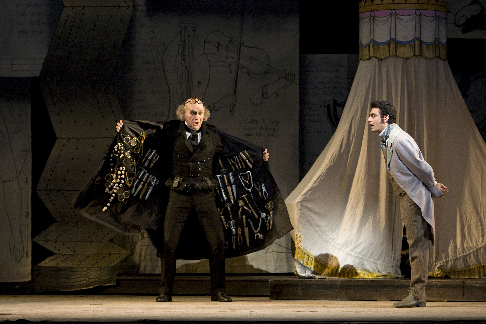 Rolando Villazón as Hoffmann and Gidon Saks as Coppélius
Rolando Villazón as Hoffmann and Gidon Saks as Coppélius
So, this was Rolando Villazón’s evening. There have been endless musicological speculations about missing, eliminated, reconstructed and re-positioned material. Here the Venetian Act was placed second, making nonsense of Hoffmann’s progression from hope of first material, then unworldly, fulfilment to disillusionment and despair. Thus, this production relied on its Hoffmann to unite the self-contained acts and to provide continuity and credibility. While some might complain that Villazón’s acting was at times overly frenetic and hyperactive, there is no doubt that his commitment to the role is absolute: and he conveyed Hoffmann's descent from youthful naïf to alcoholic cynic with total conviction. If Villazón took a little while to warm up vocally, this is understandable given the stamina required for such sustained musical and dramatic commitment. And, in the concluding moments, the slightly guarded tone of the earlier acts blossomed into a radiating timbre of myriad colours. Just what the audience had been waiting for.
Claire Seymour
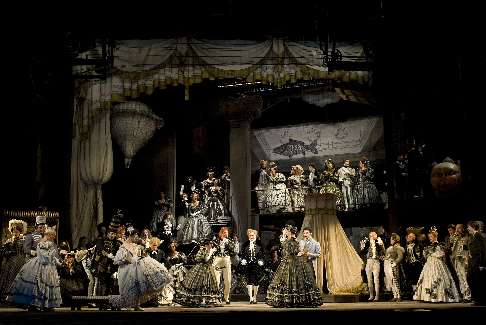 A scene from The Tales of Hoffmann
A scene from The Tales of Hoffmann
All photos by Bill Cooper courtesy of Royal Opera House
November 25, 2008
Hickox death sparks artistic review
Joyce Morgan [Sydney Morning Herald, 26 November 2008]
It should have been a joyful reunion. Richard Hickox, buoyed after a critically acclaimed series of concerts in Britain, was looking forward to the arrival of his family from Sydney.
Debussy’s Pelléas - a fine swansong for Independent Opera in London
For many devotees of Debussy’s great work this might have seemed heresy and doomed to failure, but they would have been wrong. For three nights at Sadler’s Wells’ Lilian Bayliss Theatre in London last week capacity audiences were treated to not only a magnificently innovative production but also to a highly successful and totally sympathetic orchestral reduction of the score that never once sounded thin or lacking in texture and Debussian detail.
Add to this some very promising young voices, nurtured in the tradition of Independent Opera, and this was a fine way to end, sadly, a programme of opera stagings by Independent and to set the bar high for any similar undertakings in the future.
The atmosphere of fatalism, of humans moving within the eternal constraints of their kind, enclosed in the “forest” of the castle’s stifling social norms was brilliantly realised with a dark set consisting of 3 zig-zag wooden walkways supported by pillars which created both a “pit” for the musicians underneath and an exit and entry space, on occasion, for the singers. The castle’s permanent residents, Arkel and Geneviève, move mainly on wires controlled by “servants” (or masters?)visible at the sides of the walkways, presumably indicating their incapacity to break out of the prison of their own making, whilst the other characters are “free” to move at will. All are dressed in the constricting costumes of the opera’s own time, circa 1902, and everything seems to have a patina of dust and dereliction about it, with both castle and grotto, forest and seashore, merely hinted at with single props and occasional flats. Mélisande, the focus and intuit of this psychological drama, seems to emerge from these shadows, is illuminated briefly and fatally as she embarks on her relationships with Golaud and Pelléas, and returns to whatever realm she came from, leaving her child as legacy, or, possibly, her curse.
If the design, set and direction (Madeleine Boyd/Alessandro Talevi) worked memorably well, then it was entirely complemented by Stephen McNeff’s scholarly but entirely sympathetic new orchestration for 35 instruments. Never once did one feel anything was missing — the smaller space absorbed the smaller string sound, and other important Debussy sound-world effects were retained by clever reallocation of parts. Significant obbligatos — flute, harp, oboe etc — were all there, and if this put more strain on the soloists, it didn’t show. Stylish and dramatic by turn, effortlessly idiomatic, conductor Dominic Wheeler gave this refined version the attention it deserved.
The singing was uniformly good, sometimes excellent, with the many French speakers in the cast keeping the all-important rhythm and style of the libretto intact. If Ingrid Perruche was a trifle too robust, both vocally and physically, for an ideal Mélisande, there was no doubting her abilities to interpret the text intelligently. Her most believable Pelléas was the young Norwegian baritone Thorbjørn Gulbrandsøy who, after a slightly strained start, sang with fluency and the requisite ardour, making light of the high tessitura. In perfect contrast to him was the dark, resonant bass-baritone of Andrew Foster-Williams as the tortured Golaud, a singer whose voice has blossomed into something very special these past few years. The tone was fully supported and consistent through the range, he has power to spare and obviously relishes this kind of dramatic challenge relatively early in his career; it cannot be long before his Golaud is taken up by a major house. The Arkel of bass Frédéric Bourreau was assured and poignant — he managed to convey a sense of what the old king might once have been — whilst Marie Elliot as Geneviéve used her warm mezzo to good effect, despite the quite literal confines of her role. Young soprano Caryl Hughes as the child Yniold cleverly whitened her voice to almost boy-soprano tone and was convincing as the innocent vaguely troubled by what he observes around him. Young Czech bass Vojtech Safarik sang his few Doctor’s lines with assurance.
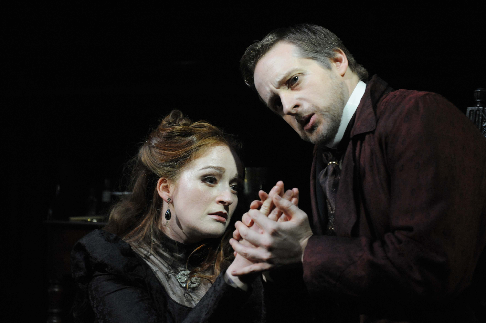 Ingrid Perruche (Mélisande) and Andrew Foster-Williams (Golaud)
Ingrid Perruche (Mélisande) and Andrew Foster-Williams (Golaud)
This was opera as it should be but seldom is — innovative yet respectful, ambitious yet pragmatic, and above all committed to the development of talent in all departments. We shall miss Independent Opera’s productions in the UK and can only hope that their ideals are carried on elsewhere.
Sue Loder © 2008
image=http://www.operatoday.com/Pelleas3.png image_description=Ingrid Perruche(Mélisande) with Thorbjørn Gulbrandsøy as Pelléas [Photo by Robbie Jack courtesy of Independent Opera Company]
product=yes
producttitle=C. Debussy: Pelléas et Mélisande
productby=Pelléas (Thorbjørn Gulbrandsøy); Mélisande (Ingrid Perruche); Golaud (Andrew Foster-Williams); Arkel (Frédéric Bourreau); Geneviève (Julie Pasturaud (18 & 20 November), Marie Elliott (22 November)); Yniold (Caryl Hughes); Médécin (Vojtěch Šafařík (18 & 22 November), Vuyani Mlinde (20 November)); Berger (Dominic Wheeler); Child (Anna Wheeler). Independent Opera Company. Conductor: Dominic Wheeler. Director: Alessandro Talevi, Designer: Madeleine Boyd.
product_id=Above: Ingrid Perruche (Mélisande) with Thorbjørn Gulbrandsøy as Pelléas
All photos by Robbie Jack courtesy of Independent Opera Company
The MET Celebrates 125th Anniversary with Gala Performance 3/15
By BWW News Desk [25 November 2008]
The Metropolitan Opera celebrates its 125th anniversary year with a unique gala performance on March 15, 2009 at 6:00 p.m., featuring Met stars in recreations of historic classic productions and high points in the company’s past. Music Director James Levine conducts the evening of 26 staged scenes that, with the use of projections, and scenic and costume recreations, will evoke the Met’s illustrious history.
La traviata, Komische Oper Berlin
By Shirley Apthorp [Financial Times, 24 November 2008]
This Violetta has her pimp with her, a well-built and violent young man. We know that he is violent because he has knives. We know that he is well-built because he is half naked. At Flora’s party, the assembled party guests hold him fast and cut out his heart. Alfred and Douphol take turns sticking skewers into the excised organ instead of playing cards. It spurts little gouts of blood. The pimp later reappears, heartless but otherwise whole.
Boston Early Music Festival Opera This Weekend--Tickets Are Going Fast!
[MarketWatch, 24 November 2008]
The Boston Early Music Festival presents two stunning, semi-staged one-act operas this weekend—an elegant double-bill featuring lush costumes, splendid dancing, unforgettable singing, and the romance of 17th century story-telling, and all accompanied by the Grammy-nominated Boston Early Music Festival Orchestra.
Boris Godunov at ENO
One is Handel; the other, the large-scale Russian repertoire. It has been almost six years since the company last tackled the latter, but that revival of Khovanshchina left such an indelible impression that a new foray into this sector of the repertoire could not have been more eagerly awaited.
It is, to my mind, a shame that ENO chose to give Boris Godunov in its original seven-scene version of 1869. Running slightly over two hours, without an interval, it certainly has its merits in terms of dramatic tautness and momentum, but it is undeniably a weaker and poorer piece than the later versions. Most crucially, it lacks almost all the political and religious context of the later, longer version. The missing Polish act holds vital pieces of the jigsaw when it comes to Russia's history with Lithuania – it actually supplies the bedrock for the whole story. Without those scenes, all the focus is thrown onto Boris's private demons and the hardships of the Russian people. It is almost an entirely different opera.
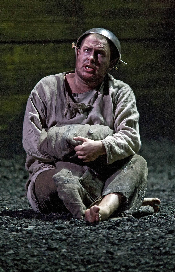 Simpleton (Robert Murray)
Simpleton (Robert Murray)
Tim Albery's new production follows through the idea of stripping the
piece bare. Tobias Hoheisel's set is simple and unusually austere; the entire
opera seems to take place in a giant wooden crate, perhaps a barn. Various
different rooms are created by platforms which slide in and out or come out
hinges. It's a drab brownish-grey, the colour of the peasants' costumes. When
colour is used, it is generally for effect; against this muted background,
the rich patterns of Boris's coronation robe are as garish as the clanging
bells up in the Balcony. Grigory's red hair instantly marks him out as a
figure of interest. The Innkeeper (Yvonne Howard) is vividly attired too, and
her mobile bar is a colourful affair – a welcome break for travellers
from the surrounding dreariness. Together with costume designer Brigitte
Reiffenstuel, Albery has done his best to make the action timeless by
combining costume designs from different periods. The peasants' attire is
generically 20th-century, while Boris's coronation seems to take place
centuries earlier; other costumes fall somewhere in between.
Peter Rose played Boris as a man whose occupation of the throne is as uneasy as he feared it would be. There was a warmth to his portrayal which made Boris likeable; the mad scene was never really gripping or hair-raising, but was full of pathos. Vocally, he held his own, with a sharper focus than I have heard in the past, though his expressive range is limited.
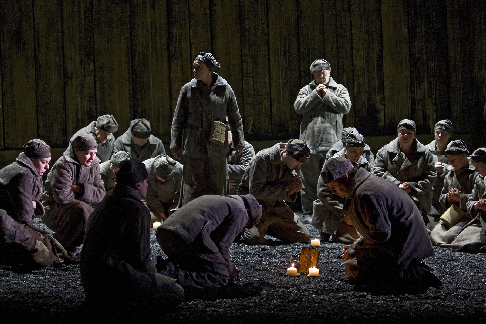 Scene from Boris Godunov
Scene from Boris Godunov
The staging makes much of the Simpleton; curled up in one corner of the stage during the final scene, he witnesses Boris's breakdown and eventually leads the dying Tsar off into the beyond. Robert Murray's clear, lovely tenor was ideal, imbued with innocence and pathos.
The American tenor, Gregory Turay, was a handsome and secure-voiced Grigory, while John Graham-Hall was a wraith-like Shuisky, the pointed precision of his diction making him all the more sinister. Brindley Sherratt's Pimen was outstanding.
Although this version of the piece barely gives either of Boris's children an opportunity to make their mark, Sophie Bevan was an attractive and lyrical Xenia, and Anna Grevelius a confident Fyodor. (Xenia's second costume – the most striking of the whole production wardrobe – was worn for a ten-second dash across the stage, and again for the curtain call. What a waste!) Jonathan Veira was a characterful Varlaam.
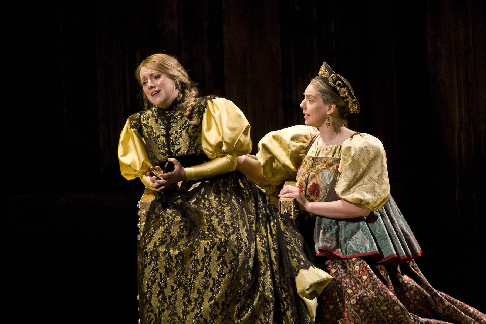 Xenia (Sophie Bevan) and Nurse (Deborah Davison)
Xenia (Sophie Bevan) and Nurse (Deborah Davison)
The opening scene did not show the (greatly augmented) chorus in their best light, with the ladies especially sounding shrill and vibrato-laden – but they rose to the challenge as the evening went on. The orchestra was magnificent under the baton of ENO's Music Director Edward Gardner, with muscular sound, sensitive phrasing, and particularly fine playing from the woodwind section. Now can we have the rest of the opera, please?
Ruth Elleson © 2008
image=http://www.operatoday.com/Boris_Godunov_011.png image_description=John Graham-Hall as Prince Vasily Shuisky and Peter Rose as Boris Godunov [Photo by Clive Barda] product=yes product_title=M. Musorgsky: Boris Godunov product_by=Boris Godunov (Peter Rose); Prince Shuisky (John Graham-Hall); Andrei Shchelkalov (David Stephenson); Pimen (Brindley Sherratt); Varlaam (Jonathan Veira); Nikitich (Charles Johnston); Simpleton (Robert Murray). English National Opera. Conductor: Edward Gardner. Director: Tim Albery. Designer: Tobias Hoheisel. product_id=Above: John Graham-Hall as Prince Vasily Shuisky and Peter Rose as Boris GodunovAll photos by Clive Barda courtesy of English National Opera
La Bohème in San Francisco
On the downbeat it quickly parted to reveal a scenic contraption that was a garret of sorts, its mattress elevated on a pile (illustrated, not real) of books, and an admonition written on the wall Se plaindre c’est un perdre du temps (for those of the audience who didn’t know French or were sitting too far away to read it, this told us that complaining is a waste of time).
So, let us not waste time on what we found lacking, and get right to what we liked. San Francisco Opera Music Director designate, Nicola Luisotti, participated with every syllable uttered on the stage, literally quivered with every emotion, and wrenched very grand pathos out of Puccini’s sad little story. Donald Runicles’ San Francisco Opera Orchestra responded full bore to their new maestro with renewed lyricism and resplendent tone proving itself again one of the world’s fine operatic ensembles.
Moments of extraordinary verismo abounded. The monochromatic tenor of Piotr Beczala made sudden sense in the third act when Mo. Luisotti orchestrally evoked the naïve, adolescent recognition of new feelings by what seemed to be an emotionally retarded tenor. The fourth act duet of reconciliation shivered with tiny flashes of love, and finally the sudden, overwhelming orchestral cry, joined by that of Rodolfo, shattered the silence of death.
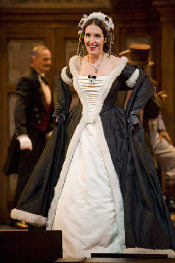 Norah Amsellem (Musetta)
Norah Amsellem (Musetta)
Back at the first act, Mimi and Rodolfo sustained full throated high “C’s” offstage as the garret contraption disappeared into kinetic openness of a Parisian place. Illustrated hotels de la ville materialized in front of our eyes in a surprisingly simple, and pleasing a vista transformation of scene. The Cafe Momus later materialized much less elegantly, to become populated suddenly and a little strangely by a noisy crowd of youngsters — the amazing San Francisco Boys Chorus (with some members of the San Francisco Girls Chorus) singing boisterously and joyfully, and always on the beat.
The big house extravagance of a real marching band (two drums, four trumpets, two piccolos) parading noisily across the stage at the end of Act II was deeply satisfying too. Some of the best Boheme’s understandably occur in provincial theaters where resources are usually as humble as are the opera’s protagonists, and where it is far more cost efficient to render this lively musical climax from the pit.
If Maestro Luisotti gave us the very real if overscaled emotions of verismo, Angela Gheorghiu gave us simplicity itself as the ill-fated Mimi. She was the evening’s only believable and real character, achieved by la Gheorghiu with true artistry, artistry that often tested, and sometimes even teased her considerable, sophisticated vocal technique. Madame Gheorghiu (she is an officier de l’Ordre des Arts et des Lettres) indeed creates a vocally complex Mimi. That it is so physically manifest (acted out) is another matter, understandably irritating to the uninitiated, and irritating to stage directors who are almost universally not among her fans.
One can only sympathize with Mme. Gheorghiu in her trials with Lyric Opera of Chicago regarding an AWOL from her Chicago Boheme manquée rehearsals to visit Roberto who was singing Faust just then at the Met (if there is possibly anyone who does not yet know, the French tenorissimo Roberto Alagna is her husband). As Mme. Gheorghiu knows, Mimi is the calm center of the maelstrom of emotions that are La Boheme. What more is there for her to do than walk on stage at the end of Act I and sit on the bed while Rodolfo sings, sit at a table at the Cafe Momus while Musetta sings, hover in the background in Act III while Rodolfo and Marcello sing, and lie in bed in Act IV while her friends emote one by one. Quite obviously it is Mimi’s friends, not Mimi, who need rehearsal time as they are the ones who complete the show.
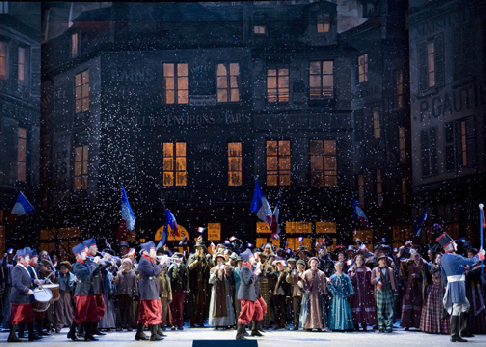 Scene from Act II
Scene from Act II
These San Francisco Opera performances of La Boheme (the last one will mark the two hundred twenty third SFO performance of Puccini’s little opera) bare the delicacy of this masterpiece when attempted with extravagant operatic resources. In San Francisco the problem was integrating smaller scale artists — singers, directors and designers - with great artists and with grand opera scale choral, orchestral and technical resources.
Michael Milenski
image=http://www.operatoday.com/BohemeSFO169.png image_description=Piotr Beczala (Rodolfo) and Angela Gheorghiu (Mimí) [Photo by ]
product=yes
producttitle=G. Puccini: La Bohème
productby=Mimì: Angela Gheorghiu / Maija Kovalevska (11/29, 12/4, 12/7) / Melody Moore (12/2); Rodolfo: Piotr Beczala / Marius Brenciu (11/29, 12/4, 12/7); Marcello: Quinn Kelsey / Brian Mulligan (11/19, 11/22, 11/29, 12/4, 12/7); Musetta: Norah Amsellem / Tamara Wapinsky (11/29, 12/4, 12/7); Colline: Oren Gradus / Kenneth Kellogg (11/29, 12/4, 12/7); Schaunard: Brian Leerhuber; Benoit, Alcindoro: Dale Travis; Parpignol: Colby Roberts; Customhouse Sergeant: David Kekuewa; Customhouse Officer: Jere Torkelsen; Prune Vendor: Chester Pidduck. Conductor: Nicola Luisotti / Giuseppe Finzi (12/4, 12/7). Director: Harry Silverstein. Set Designer: Michael Yeargan.
product_id=Above: Piotr Beczala (Rodolfo) and Angela Gheorghiu (Mimí)
All photos by Terrence McCarthy courtesy of San Francisco Opera.
Lulu-Palooza in the Windy City
For Ms. Petersen has everything the role requires: gleaming lyric tone, unstrained high notes, first rate musicianship, a thorough understanding of the structure of the doomed girl’s dramatic arc, star presence, a waif-like figure, and truly great gams. So why was I not more emotionally engaged with her very definitive achievement?
Well, for all her consummate professionalism, she seemed to be just on the fringes of the character’s soul. The great director/teacher Charles Nelson Reilly once critiqued an actress thus: “My dear, you are wonderful, but you’re not acting — you’re giving a ‘performance.’” And that in part is what I felt about Ms. Petersen. Wonderful ‘performance,’ yes, but where was the internalized gnawing motivation that informs this creature? In her defense, and to risk musical heresy, I feel that in large part the omission is composer Berg’s.
The text asks us to believe this woman is irresistible, a charismatic being that inspires unhealthy sexual obsession in all who cross her path. I was not yet convinced this night that the intent of the tale is borne out by its musicalization. The heroine’s churning prosaic declamation, the oft-angular leaps, the quirky melismas that sound like “Lucia” on a bender, the pitches in extremis where only dogs can hear — all these make me admire the technique and the intellect to be sure, but do not engage my emotions. Or my libido.
Perhaps a uniquely gifted stage creature like Natalie Dessay could truly inhabit this role and make the dramatic work. Until then, Ms. Petersen’s very real achievement will likely nevertheless give much pleasure to many fans of this troubling piece. Not that hers was the evening’s only success.
The talented and versatile William Burden was simply the best Alwa of my experience. Is there anything at which this accomplished tenor does not excel? Here he sang with his customary easy precision, and spun out some achingly beautiful phrases. His duet with the heroine was arguably the highpoint of the evening. Dramatically committed, pristine tone and technique, handsome presence, Mr. Burden delivered on all counts.
The much anticipated Lyric debut by Wolfgang Schoene, a notable Dr. Shoen, was impressively musical and secure of characterization. His rather straight vocal production certainly filled the large house, although I found it a little on the dry side. Still, nothing about the part escapes him and he was often thrilling and ultimately (as Jack) chilling. Thomas Hammons’s booming, orotund Schigolch was more to my vocal taste and he made the most of his stage time. The rich, ringing contralto-ish Countess Geschwitz from Jill Grove was also top drawer, and she had good fun with parts of the role, running around in the bustle of Act II like Estelle Parsons chasing the getaway car in Bonnie and Clyde.
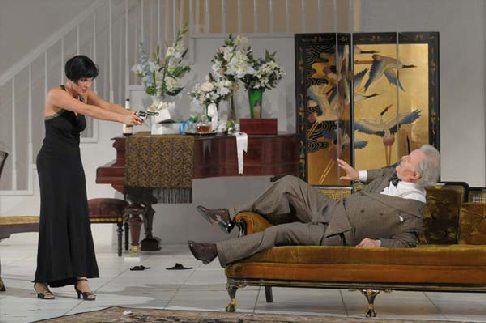 Marlis Petersen (title role) and Wolfgang Schöne (Dr. Schön) in Lyric Opera of Chicago’s new production of Lulu, directed by Paul Curran for the 2008-09 season. Photo by Dan Rest/Lyric Opera of Chicago
Marlis Petersen (title role) and Wolfgang Schöne (Dr. Schön) in Lyric Opera of Chicago’s new production of Lulu, directed by Paul Curran for the 2008-09 season. Photo by Dan Rest/Lyric Opera of Chicago
The many featured roles were well taken by Lyric’s outstanding young artists, with Scott Ramsay’s Painter deserving special mention for his gleaming delivery. Only Jan Buchwald seemed not quite in the same league as this stellar group of soloists, with a fairly woolly and diffuse Animal Tamer. While he sang much more clearly as the Athlete, Mr. Buchwald suggested more an East Bloc WWF act than the usual trim track star.
Stage director Paul Curran managed his skilled cast with excellent results, combining meaningful groupings and well motivated blocking with often inspired stage business. He also successfully mined all the humor in the piece which greatly heightened the catastrophic outcome. Kevin Knight’s effective set design pulled off the trick of using a white-box-as-unit-environment without parodying the dreadful cliche’s of 1980’s German opera design. This handsomely detailed space was changeably adorned with well chosen dressing, and subsequently opened up at the back to reveal a beautiful multi-leveled staircase. Mr. Knight also provided the characterful costumes.
If anything, I felt the white set was perhaps too clean, too bright, too open for the dark undercurrents of the story. But I grouse. The overall look of the design was a fine artistic achievement, especially paired with the spot-on (as it were) projections and film work contributed by John Boesche, and as meaningfully lit by David Jacques. First rate all.
In the pit, Sir Andrew Davis drew exceptional playing from this fine band, and made as cogent a case as I think possible for Berg’s opus. The occasional volume imbalances between orchestra and stage are seemingly unavoidable, given the thick brass voicings at some key junctures. The highly affecting, personalized solo instrumental work was equaled by superlative ensemble playing.
I cannot imagine a better case being made for this complex, challenging piece of musical theater. Still, after four different (good) productions to date, and many earnest “listens,” I frankly still don’t respond to the score. My limitation, I know. That I am not alone was evidenced by a trickle of audience leaving at the first intermission, augmented by a stream of departees after Act II.
At the end of the day, then, I have to say I found myself totally loving most everyone and everything about Lyric Opera’s admirable Lulu except…it.
James Sohre
image=http://www.operatoday.com/LuluLOC06.png image_description=Wolfgang Schöne (Dr. Schön) and Marlis Petersen (title role) in Lyric Opera of Chicago’s new production of Lulu, directed by Paul Curran for the 2008-09 season. Photo by Dan Rest/Lyric Opera of Chicago
product=yes producttitle=Alban Berg: Lulu productby=Lulu: Marlis Petersen; Dr. Schön/Jack The Ripper: Wolfgang Schöne; Countess Geschwitz: Jill Grove; Alwa: William Burden; Schigolch: Thomas Hammons; Painter/Black Man: Scott Ramsay; Animal Trainer/Athlete: Jan Buchwald; Prince/Marquis/Manservant: Rodell Rosel; Wardrobe Mistress/Schoolboy/Groom: Buffy Baggott. Lyric Opera of Chicago. Conductor: Sir Andrew Davis. Director: Paul Curran. Designer: Kevin Knight. product_id=Above: Wolfgang Schöne (Dr. Schön) and Marlis Petersen (title role) in Lyric Opera of Chicago’s new production of Lulu, directed by Paul Curran for the 2008-09 season. Photo by Dan Rest/Lyric Opera of Chicago
November 23, 2008
The ‘Colors’ of La Fanciulla
The twentieth-century phase (from La Fanciulla del West to Turandot) is tidily compartmentalized from the fin de siècle phase (from Manon Lescaut to Madama Butterfly). In the former, a manifestation of a distinct sensibility for the crisis in the operatic form of the period and (without a refutation of a dramatic style grounded in realism) the adoption of a series of innovative strategies in the realm of diversification of subjects, refinement of musical means, exploration of staging resources, in a word toward the reorientation of dramatic perspectives as a whole, can be discerned.Beyond the convergence of orchestral language and musicality with a few of the primary exponents of European musical modernism such as Debussy, Strauss and Stravinsky, certainly meaningful and conscious reverberations in an ever forward-looking musician, one of the most evident hallmarks of Puccini’s twentieth-century period is the retrospective itinerary which his dramatic style follows. The high point of Puccini’s modernity is thus attributed to works such as Il Trittico and Turandot. In the three parts of Il Trittico a manneristic compendium of outdated genres and dramatic styles is realized: from the Grand Guignol realism of Il Tabarro (a revisiting of veristic subjects in his 1890s style), to the sentimental opera centered on the heroine’s tragic fate in Suor Angelica (a perfect example of Puccinian’s fin de siècle mode, colored by archaic musical pieces grounded by the liturgical context of the story), to the recuperation of the comic genre in Gianni Schicchi (which, differing from the contemporary reconstructions of eighteenth-century buffo, brings a non-restorative comic style, based on contemporary language and staging). In Turandot a binary option for the revival of the operatic genre is offered: on one hand, through the reformulation of the fairy tale under a mythical heading; on the other, through the meticulous reconstruction of the forms of nineteenth-century melodrama (commonly referred to as the “solite forme” of operatic works).
Another option of modernist dramaturgical rethinking is at play in Puccini’s twentieth-century works: that of stylistic fragmentation, of breaking down compositions into heterogeneous linguistic blocks, in keeping with the standardized categorization of vocal types and of the dramatis personae. Again Turandot is the culmination of this trend. A musical articulation in blocks bases itself on an array of character types and situations (the tragic, solitary Turandot and the sympathetic slave Liù; the heroism of Prince Calaf which launches his dual challenge to the enigmatic and stunning princess, and the sentimental side of a Calaf who is interested in the fate of the little slave girl; the grotesque masks [Ping, Pang and Pong]). At some moments these blocks are carved out of the free use of dissonant intervals and harmonic units (Turandot’s imperious and cruel sphere), at others from the exotic material of pentatonic scales and authentic Chinese melodies (the marionette-like irony of the masks, but also the human side and intimate innocence of Turandot). Still others come from the sentimental and poignant melodies of Puccini’s normal style (generally the parts of Calaf and the slave Liù). The humanization of Turandot, her metamorphosis from purveyor of death to a being capable of love, is therefore put together through a series of frontal juxtapositions in which the princess collides with registers and stylistic levels expressed by the other characters (Turandot’s cruelty and Liù’s sacrifice, the Prince of Persia’s failure and the unknown prince’s success, the icy body of the death-princess and the “burning hands” with which Calaf crushes her in his ardent embrace). This metamorphosis corresponds more to the opera’s complex dramatic and visual program than in the character’s internal motivations. The opera beats out the chronological proceeding of the story, from sunset to sunrise, from the cold spite of the moon’s silvery reflections to the warmth of the sun’s golden rays. [1]
From both of these points of view, the problem of La Fanciulla del West remains an open one: according to a widespread tradition of interpretation, it is a “difficult” opera, one of transition, in part unresolved on the level of dramatic/musical coherence, a work of crisis, not yet one of reformation, a recognition of a new path but of a path not yet taken with confidence. Even pioneer supporters of the modernity and novelty of Puccianian dramaturgy such as Fedele d’Amico, (who never tired of repeating that Puccini has always been modern, be it when the “naturalist”in the common, petit-bourgeois sense of the word, prevails in him, or when the “twentieth-century, aestheticizing” musician dominates, that is when he “is capable, in his own way, of that decadent distancing from his own material” which forms the dividing line between nineteenth- and twentieth-century music) succumb to doubts and display substantial reservations when faced with Fanciulla: the Puccinian western is thus the opera in which music comes to be reduced to an “abstract theatrical gesture,” to the “incoherent marginal notes , which reigns over one stylistic element alone, rigorously abstracted from the others: the orchestral color.” [2]
Following the maestro’s remarks on the opera one gets the impression that Fanciulla del West was a turning point, which anticipates and leads to the masterpieces of Il Trittico and Turandot. The choice of the drama’s subject, David Belasco’s [1905] The Girl of the Golden West, difficulties encountered with the new pair of librettists (Guelfo Civinini and Carlo Zargarini) which led to the composer’s assumption of almost the entire creative workload, as well as the opera’s long gestation period (longer than any other of Puccini’s works) which drew on until the New York première of 10 December 1910, all crown a period marked by a veritable anxiety over change (the “mania of pushing on…with a modernly constructed and intended work” Puccini disclosed in a letter in February 1905, right after Madama Butterfly) and dramatic restructuring:
Sometimes I think about something like La Bohème, the tragic and sentimental mixed with the comic (and I believe that this genre could stand to be reformed, certainly with different customs and practices, and thus it will require new settings, less sweet sentimentality (that is in a smaller quantity) and more “déchirant” drama. [3]
There we have it! The Girl promises to be a second Bohème, but stronger, bolder, fuller. [4]
It is precisely by means of Puccini’s twentieth-century perspective, which aims at a systemized linguistic flexibility and the composition of opera as a moment of retrospection and reformulation of languages, styles and forms, that in this essay I intend to propose a reinterpretation of the essential elements of Fanciulla del West , and in particular of those which express the “primary colors” of the story and its heroine.
1. The miners’ “sister”
The aspect of vocal types is one evident feature that distinguishes Fanciulla from previous Puccini operas. The usage of only one female voice, the soprano Minnie — the Indian-girl Wowkle, mezzo-soprano, has an entirely marginal role — counterpoised against the dense group of voices of the male characters who populate the miners’ camp (at the foot of the Cloudy Mountains in the Californian Sierra at the time of the Gold Rush) establishes a hitherto unheard of vocal dynamic, which poses entirely new problems of musical equilibrium to the composer. Such problems can be seen in two areas: firstly, from the point of view of individual differentiation, as is the case with the sheriff Jack Rance and the miner Sonora, both baritones but with opposite qualities, the former treacherous and scornful, the latter noble in spirit (a strategy that in hindsight prefigures one of the key elements of the drama of Suor Angelica). Secondly, problems arise from the point of view of the group treatment of the legion of basses, baritones and supporting tenors. Puccini’s solution here creates the peculiar vocal color of Fanciulla. Gianni Schicchi will be the most direct development upon it.
Overall, this kind of collective yet internally differentiated male character, composed of a mix of gold diggers, adventurers and outlaws, is the expression of a primitive society without rules, a world of crude men. As the stereotype would have it the men are drunk, cheating, trigger-happy, indifferent toward life and uncaring about death (“Evvia! Che è poi la morte / un calcio dentro al buio e buona notte” according to Sheriff Rance’s cynical philosophy). It is deep within this society that Minnie – the woman with a pistol, vigorous, and, if necessary, brutal administrator of the “Polka” saloon, by collective trust and common maternal identification the guardian of the camp’s fortunes – expresses the “energetic,” “savage,” “wiry” side of her personality. The musical color that connotes this sphere of action and this aspect of the protagonist is rough and vigorous, its fundamental qualities are its cutting rhythm, its asymmetrical phrasing, a dissonant and thorny harmonic language (unrelated harmonies of sevenths, ninths, elevenths, augmented chords, whole tone scales), a moment of vocal heroism for Minnie. To illustrate that this color is a permanent and unchangeable feature of this particular society, there is a series of episodes distributed in the arc of the entire opera: in Act I, the episode of the attempted hanging of the cheater Sid (“Al laccio il ladro!”) and the squabble between Rance and Sonora, interrupted by Minnie’s forceful reprimand (“Mistrees Rance, fra poco”); in Act II, the scene in which Rance and his men burst into Minnie’s hut (“Chiamano…chi sarà”); in Act III, the episodes of the manhunt (in the score two measures after rehearsal number 5), of Johnson’s capture (“A morte!”) and of his subsequent rescue by Minnie (from rehearsal number 29 on).
2. The “povera fanciulla oscura, e buona a nulla” and the bandito
A distinct color shows the other side of Minnie’s personality: a girl who is “sweet,” “civilized,” (the little schoolteacher of the camp with “only thirty dollars of education” and a taste for romantic novels), “proudly virginal,” and “strong of spirit.” She is also deeply unsure of herself, such that she paints herself as “dim, and good for nothing.” She is a girl who paradoxically has not yet danced her first dance, nor given her first kiss in search of love. In contrast to the connotation of the “savage” Minnie, her sweet and virginal side are delineated by means of diatonic music, tonally defined or guided towards pentatonic solution, with symmetry in phrasing and a simple and smooth vocal line . In this mode the protagonist expresses her own kindly attitude toward the miners (one need only think of the episode of the catechism on Psalm LI) * and her nostalgic and dreamy declaration of regrets and more intimate desires (e.g. “S’amavan tanto” in the duet with Rance). But, above all, this dramatic-musical color plays a conspicuous role in the lady’s sentimental attitude toward Dick Johnson, the chance visitor to the Polka whom she met once before and never again forgot, with whom she retires to the intimate setting of her mountain hut and shares her first dance and first kiss, and who reveals himself to be none other than the terrible outlaw Ramerrez, desperately wanted by the men of the camp. This color is aptly prevalent in the duets between Minnie and Johnson: at the conclusion of Act I, in the moment of their tender feelings (from rehearsal number 114); in the Act II duet’s episodes of courtship (“Del biscotto alla crema?”) and of the ecstasy in their pleasure (“Minnie…Che dolce nome!”). On the whole, the dialectic expressed through the two colors in Minnie’s personality (in their opposing auditory poles of attraction) neatly encapsulates the substance of the opera, a “drama of love and moral redemption,” evincing the dramatic motif that Puccini desperately wants to draw out of Belasco’s drama:
…in the adaptation of such violent source material I brought the inspiration of a vibrant and refined idealism , toward the end of encircling those catastrophic human events in a dreamlike atmosphere. In Belasco’s drama, for example…little emphasis was placed on the redeeming quality of the protagonist: it was I who had the librettists develop this to a greater extent, and thus this desire for purification, this pained cry for peace gained through love and hard work, became more clear and truthful. [5]
Without delay, Puccini attracts attention to this dramatic nucleus starting from the theme of the symphonic introduction, played before the curtain opens on the saloon. The theme of the introduction indeed presents a two-pronged makeup, dissonant and choppy in Minnie’s “savage” color in the first part, diatonic and in her sweet and spiritual color in the segment which follows. In fact, the interplay between love and redemption presented an opportunity new to Puccinian dramaturgy, which had hitherto conceived of love only in tragic terms, as an error to be remedied by death. Conversely, in Fanciulla, the social and moral rehabilitation of Johnson/Ramerrez is a sort of function of the sentiment of love, or a direct consequence thereof. Indeed this is achieved neither by means of an interior maturation of the characters nor by a development in their psychologies. Minnie stays concurrently savage and sweet throughout. This manifests itself primarily in her extreme gestures of bandit savagery: she is deceitful in the poker game with Rance and masculine and willful when she bursts onto the scene of Johnson’s would-be execution; however, she is also maternal and imploring when she attempts to win the miners over. Johnson is a two-dimensional character: a kind outlaw and a generous man from the beginning to the end. Redemption, therefore, results from nothing but a choice between two equally possible options (human affection instead of worldly possessions, loving Minnie instead of stealing gold), which the little schoolteacher’s exegesis of Psalm LI prefigures as the actuation of a destiny inscribed forever in the history of every man:
That means, boys, that there exists,
No sinner in the world
To whom a path to redemption is not revealed…
May each of you learn within yourself
To enclose this supreme truth of love
3. The ‘far-off’ West and the Waltz
To make this perspective evident, to dramatically realize it in music, stand two examples from Act I that blend into the action as simple stage music : the song of the balladeer Jack Wallace, “Che faranno i vecchi miei,” and the music of the waltz danced by Minnie and Dick Johnson at the Polka. These two pieces, which belong to the sphere of Minnie’s sweet and contemplative side, little by little come to signify the conceptual totality of dreams, nostalgia (the theme of homesickness, the desire to return to the home and family affections) and redemption through the passion of love. The song the minstrel entertains the miners with in Minnie’s saloon, which elicits a collective sentiment of despair and aggravates Larkens’ nervous state, is the first moment of real cantabile and the first long piece in the opera with tonal stability. Here Puccini combines a paraphrasing of the general tone and particular imagery found in the lyrics of a song from the repertoire of Californian balladeer music, known as Old Dog Tray (utilized in the intermezzo of the performance of Belasco’s Girl which Puccini attended at the beginning of 1907), with the melody of an original Zuni Indian chant (published with the title “The Festive Sun Dance of the Zuni” in 1904, arranged by the German-American composer Carlos Troyer). [6] This piece, which represents the primary locus of exotic color in the entire opera, is however tempered in part by a series of transformations in its melodic contour and by its operatic instrumentation, both of which diminish the piece’s most markedly “Indian” effects, in so doing emphasizing instead the symmetry and cadential regularity of the phrasing and thus conferring an “American” character, giving the piece a sort of melancholy cowboy air.
The dramatic impact of this piece is highlighted by the recurrence of its verbal theme (the persistent reiterations in the libretto of motives of homesickness and leaving for home), its musical theme (which comments upon Minnie’s biblical exegesis), and of both the verbal and musical theme (the baritone’s off-stage voice as the curtain rises and in the heartrending farewell epilogue). All this means that Sehnsucht [yearning or longing] for this other place, this remoteness found from top to bottom in Fanciulla, adds tension to both the change of place and living conditions we witness. This tension reaches a climax at the end by means of Johnson’s departure for a trip without return, signifying his redemption.
The waltz eases this process of metamorphosis. It is the second moment of real cantabile and the second long piece in the opera with tonal stability. Its melody, hummed by the miners in a musically crude fashion (without words and with a thin rhythmic accompaniment), at first a carefree little picture of the settings, slowly turns into a Puccinian cliché, that of a seduction dance, following the model of Musetta’s waltz in La Bohème. Once internalized by Minnie and Johnson, the dancing melody in fact becomes the primary color of their private sphere and, therefore, recurs as a principal component of the lyrical pieces that involve the two. These pieces start with and consistently return to the waltz, almost as if to suspend the situation (and associated sensations) until the moment in which it ends in the tumultuous embrace of the Act II duet.
4. “Parlante” vocal strategies
The repeated use of the waltz melody in the sung parts of the protagonists’ duets should also be read as a manifestation of melodic economy, in keeping with an aim of Puccini’s era to reject the appeal of fluent and versatile singability. Indeed one of the fundamental choices in composing found in Fanciulla del West is the interaction between singing broken down into small bits of declamation , with a melodic poorness so often exhibited that it constitutes a pattern, and the richness of the orchestral arrangement, which conversely is brought to life by its motifs, in the originality of its timbre, in the fullness of its harmonic writing. These are among the most evident symptoms of Puccini’s breaking away from the operatic dramaturgy of the nineteenth century and the extent to which he was moving toward a certain type of melodrama that at the time, in Italy, found its most solid support in the best productions of d’Annunzian decadent style of (for example, in the austere declamatory style of Ildebrando Pizzetti’s Phaedra).
In Fanciulla the orchestra takes on both a lyric and dramatic function, the latter parallel to the singer’s verbalism, beyond assuming the primary staging/narrative functions in the plot often articulated by dialogues (the whole act at the Polka) and those of scenic division in the crowd sequences (a brilliant example is the chase episode in Act III, which alternates between crowd sequences and “close-ups” dictated by thematic development in the orchestra). The vocal lines instead defy standard Italian song style; they remain in declamato for long periods according to a great number of suggestions, from “almost spoken” to “spoken low,” “spoken gracefully,” “spoken loudly,” and in many instances are reduced to true recitation with no musical intonation given.
In the economy of the opera as a whole, these declamatory moments function as a means by which to contain Puccini’s more typical style, which in pieces conventionally given over to lyric outbursts (e.g. the three duets: between Minnie and Rance in Act I and the two between Minnie and Johnson) remains more or less restricted to only a select few, very short phrases within the opera’s melodic spectrum, integrated into the underlying dramatic tapestry: one of these is Rance’s phrase “Or per un bacio tuo” in his duet with Minnie, another is Minnie’s “Io non sono che una povera fanciulla” in her first duet with Johnson. Others include the motif of Johnson’s kiss, the paired conclusion (“Dolce vivere e morir”) of the second duet, and Rance’s pseudo-aria “Or piangi tu, o Minnie” in Act III. That’s all , or nearly so.
Johnson’s aria in the last act, “Ch’ella mi creda libero e lontano” is consequently the only truly lyric number of the entire score written in the style of Puccini’s earlier melodic mode. By its formal compactness (entirely enclosed within some twenty beats of music) and by its unity of character and adherence to the dramatic situation (the last, most intimate confession of a character on the brink of death), this aria conforms to the happy model of similar pieces such as Mimì’s “Sono andati?” in La Bohème or Cavaradossi’s “E lucevan le stelle” in Tosca. Within the fragmented stylistic context of Fanciulla, however, “Ch’ella mi creda” represents nothing more than yet another vocal color, that of the fullness of love. The character Johnson, depicted with a captivating charm by his characteristic motif in a ragtime rhythm, stubbornly intent upon showing himself in the conventional role of the tenor, attempts to establish himself this way from his first entrance. A survey of Johnson’s vocal profile, however, shows him to be such only in the decisive moment of conflict with the antagonist Rance, his rival due to social status (the sheriff vs. the bandit) and personal aspirations (the suitor refused by Minnie vs. the man loved and redeemed by means of Minnie’s love).
5. A syncretic perspective
In an interview published in 1911 in the “Gazzetta di Torino,” Puccini exposes the underlying reasoning behind his own poetics at the time of Fanciulla, recalling the persistent vitality of the dramaturgy of Richard Wagner, whom he called “forefather of all contemporary music” provided one knew how to purify it of its intrinsic “adornments” and “exuberances.”
This mention of Wagner is anything but a passing thought, given that Fanciulla is surrounded on many levels by a series of Wagnerian suggestions. There is a narrative line which brings about moral redemption, as in Parsifal, although cleansed of mystic incrustations and of the Wagnerian mythology of purity: in Minnie’s harsh analysis, the men remain “outlaws and cheats”: the “gamemaster” Rance, the true “outlaw” Johnson/Ramerrez, the “mistress of the flophouse and of gambling” Minnie. There is a trace of the union of Sigmund e Siglinde in the embrace of the two protagonists who ignore the gusts of wind that batter their shack, but it is only fleeting. There is the evocation of Minnie in Valkyrie’s clothing the instant she bursts onto the scene of Johnson’s hanging, “on horseback, scantily clad, her hair to the wind,” and heralded by a “savage cry.” And there are musical reverberations that permeate a few key moments in the score. One of these affects Minnie’s motif – the vibrant and fortissimo exclamation that announces her first appearance in Act I – which, due to its beginning interval on a descending seventh as well as its melodic contour, alludes to the leitmotif associated with Gutrune in Gotterdämmerung and, in particular, to the variant thereof categorized in guides (from Hans von Wolzogen onward) as the “theme of the treachery of love.” Another reflects the reiterated use of the opening of the initial motif found in Tristan und Isolde: a commonplace Wagnerism in Italian opera, widely adopted by Puccini in Manon Lescaut, was the use of the related Tristan Chord. The four notes of which it is composed (a, f, e, d-sharp in Wagner’s original), currently classified as a “theme of suffering”, in Fanciulla appear for the first time in the final duet of Act I, at the point when Johnson attempts to mollify Minnie, who is bent on defending the miners’ gold with her life (“Oh, non temete, nessuno ardirà!”). After which, in Act II, with a harmonization structured on the tritone and a messa in sequenza in the ostinato form which reinforces the original intention of the sorrowful motif, it orchestrally highlights Minnie’s anguish over Johnson’s fate: the episode in which she succors the wounded Johnson (“Su, su, su, presto! Su, salvati!…”), the scene in which she pleads with the merciless Rance (“Aspettate, non può”), the dramatic, final bet (“Una partita a poker!”) until the act closes, in the convulsive moment of exuberance mixed with a desperate cry (“Ah! È mio”).
Beyond these Wagnerian borrowings, as numerous as conceptually unsystematic, a number of other, varied inspirations are found in the score of Fanciulla. One of these is a reformulation of the musical theme of the kiss from Verdi’s Otello in the wispy orchestral arrangement of Johnson’s thrice-requested bacio (II, 25). Another is the atmospheric effect achieved by means of a descending pattern of two tones separated by a fifth, in Act I (from 26 on). Here, as in the Barrière d’enfer (Quadro III) of La Bohème, this is a musical painting of falling snow, this time adapted to the swirling violence of a bitter and hostile En plein air. A final inspiration is a moment of recycling in the final act, in which the sequence of musical reprises is analogous to that found in the fourth quadro of La Bohème.
All in all, in Fanciulla the reformulation and recontextualization of heterogeneous elements seems to be a strategy used quite widely, involving narrative aspects, dramatic situations, musical materials and the structural groundwork for the flow of the music. It should not be interpreted as a simple exhibition of a taste for quotation. It may well be, in keeping with his tendency to compose the drama in differentiated linguistic blocks, to modify the style of stage music in primary narrative elements, and to reduce the Puccinian lyric register into a serviceable musical color, these citations are one of the fundamental terms of the transition from a dramatic style coherently concentrated on the representation of the “pathetic,” the tragic as a desperate feeling of the self, which requires full emotional involvement (following the model of Madama Butterfly), to a dramatic style articulated in its presentation of the “characteristic,” in which a pluristylism and an emotional self-distancing from the subject are essential. A stance that the finale, in its final “dissolve,” with its reprise of the choral melody from Jack Wallace’s nostalgic ballad, seals in a sort of brief tableau, in which the feeling of general commotion is nearly petrified by the total absence of lyric emphasis.
Marginal notes , d’Amico would rightly say. Nevertheless, far more than the coming together of opera, cowboy shows (the opera typically uses live horses on stage) and the nascent Western genre in American film (already embodied in the first decade of the twentieth century by more than a dozen titles), these musical and dramatic annotations written with discontinuity on the margins of the drama mark the beginnings of a new “code” in Puccini’s twentieth century style. [7] A setting in which Fanciulla, doubtless a work less compact than the short operas of Il Trittico and less polished as far as dramatic-musical makeup is concerned than Turandot, is a high-point in at least one aspect: its happy ending is a “metamorphosis” of character which follows a scheme that the difficulty of composition and Puccini’s limited lifespan would prevent him from accomplishing in the fairytale-mythical context of his last great masterpiece.
By Virgilio Bernardoni. **
Translated by Jonathan Hiller.
Edited by Gary L. Hoffman.
[1] In particular, see Ashbrook, William and Harold Powers, Puccini’s Turandot. The End of the Great Tradition. Princeton, NJ: Princeton University Press, 1991.
[2] D’Amico, Fedele. “Naturalismo e decadentismo in Puccini e La Fanciulla del West.” L’albero del bene e del male: naturalismo e decadentismo in Puccini, ed. Jacopo Pellegrini. Lucca, Italy: Maria Pacini Fazzi Editore, 2000. pp. 18, 124.
[3] Letter to Valentino Soldani from 28 June, 1904, in Carteggi pucciniani, ed. Eugenio Gara. Milan: Ricordi, 1958. pp. 277-8, n. 387.
[4] Letter to Giulio Ricordi, 26 August 1907. ibid p. 353, n. 521.
[5] Interview of Puccini by Giacinto Cattini, in the “Gazzetta di Torino”, LII, 11 Novembre 1911, p. 3.
[6] Atlas, Allan W. “Belasco and Puccini: ‘Old Dog Tray’ and the Zuni Indians” The Musical Quarterly, Vol. 75, No. 3 (Autumn, 1991), pp. 362-398.
[7] Girardi, Michele. “Il finale de ‘La Fanciulla del West’ e alcuni problemi di codice,” Opera & Libretto II [Fondazione Giorgio Cini/Studi di Musica Veneta], 1993, pp. 417-37.
* [Editor's Note: This is Psalm 50 in the Vulgate, which is commonly referred to as “The Miserere” (or Prayer of Repentance). This Psalm is David’s confession and plea for mercy after the prophet Nathan rebukes him for committing adultery with Bathsheba and having her husband, Uriah, murdered.]
[** Prof. Bernardoni is a member of the Dipartimento di Lettere, arti e multimedialità, Università deglistudi di Bergamo. This essay is translated and published with the permission of the author from the original entitled “Le ‘tinte’ della Fanciulla” (2001) (available at http://www.puccini.it/Saggi/saggio%20fanc1.htm).]
image=http://www.operatoday.com/459.png image_description=La Fanciulla del West product=yes product_title=The ‘Colors’ of La Fanciulla product_by=By Virgilio Bernardoni. Translated by Jonathan Hiller. Edited by Gary L. Hoffman product_id=Prof. Bernardoni is a member of the Dipartimento di Lettere, arti e multimedialità, Università deglistudi di Bergamo. This essay is translated and published with the permission of the author from the original entitled “Le ‘tinte’ della Fanciulla” (2001) (available at http://www.puccini.it/Saggi/saggio%20fanc1.htm).PUCCINI: La Fanciulla del West — Firenze 1954
Music composed by Giacomo Puccini. Libretto by Guelfo Civinini and Carlo Zangarini after David Belasco’s play The Girl of the Golden West (1905).
First Performance: 10 December 1910, Metropolitan Opera House, New York.
| Principal Roles: | |
| Minnie | Soprano |
| Jack Rance, sheriff | Baritone |
| Dick Johnson/Ramerrez, bandit | Tenor |
| Nick, bartender at the Polka saloon | Tenor |
| Ashby, Wells Fargo agent | Bass |
| Sonora | Baritone |
| Trin, a miner | Tenor |
| Sid, a miner | Baritone |
| Bello, a miner | Baritone |
| Harry, a miner | Tenor |
| Joe a miner | Tenor |
| Happy a miner | Baritone |
| Larkens, a miner | Bass |
| Billy Jackrabbit, a Red Indian | Bass |
| Wowkle, his squaw | Mezzo-Soprano |
| Jake Wallace, a travelling camp minstrel | Baritone |
| José Castro (mestizo), one of Ramerrez’s band | Bass |
| The Pony Express riders | Tenor |
Setting: A camp of miners at the foot of the Cloudy Mountains during the California Gold Rush (1849-50).
Introduction:
The plot is concerned with rather melodramatic happenings during the days of the California Gold Rush. While remaining true, in general, to his usual melodious style, Puccini has adapted his score to a rapidly moving conversational dialogue. He also shows that he was aware of the musical progress of the times by his use of consecutive and unresolved seventh chords somewhat in the manner of Ravel, and in the employment of Debussian augmented triads. Moreover, for the sake of local color, he introduces melodies and rhythms characteristic of the South and Southwest.
Synopsis:
Act I
Ashby, agent of the Wells Fargo Company, enters the “Polka” bar-room, and, joining the miners there assembled, says that he is close on the track of Ramerrez, chief of the band of Mexican outlaws who have recently committed a big robbery. The sheriff, Jack Rance, in talking with the men, boasts of his own love affair with the “girl,” Minnie, and says that he is going to marry her. One of the miners disputes his claim and a brawl results. Minnie herself enters and stops it. Minnie runs the “Polka,” for she is the orphaned child of the founder of this establishment, and also acts as mother and guardian angel to the miners and cowboys who frequent the place. When Rance proposes to her in his crude fashion, she spurns him and holds him at bay with a revolver. A stranger enters and gives his name as Dick Johnson of Sacramento. The sheriff is suspicious concerning him, but Minnie takes his part, saying that she has met him before. Johnson is in reality none other than the hunted Ramerrez — he has come to rob the saloon. Unaware of this, Minnie recalls with Dick the time they first met and fell in love with one another. The men all go in search of Ramerrez, leaving with Minnie their gold. She declares that if anyone is to steal the gold he must do so over her dead body. Johnson has become more and more enamoured of her and relinquishes his plan of robbery; now he admires her courage. She invites him to visit her in her cabin when the miners shall have returned.
Act II
Johnson and Minnie meet at her “shack” and sing of their love. Suddenly shots are heard outside in the darkness — the men are again searching for Ramerrez. Not wanting to be found with her lover, she conceals John¬son, then admits the men. They are hunting, they say, for Dick Johnson, who is none other than Ramerrez. Minnie declines their offered protection and they leave. Then she turns upon Johnson with the revelations that she has just heard. Dick acknowledges their truth, but goes on to tell how he was compelled by fate to become a bandit; since meet¬ing her he has resolved to give up his old life, and had prayed, in vain, that she would never know of his past. The tense dramatic atmosphere is reflected in somber chords in the orchestra.
But Minnie cannot forgive him for having deceived her after confessing his love. She sends him out into the night. A moment later shots are heard, Minnie runs to the door, opens it and drags in Johnson, seriously wounded. She hides him in a loft up under the roof. The sheriff soon enters, hot on the trail. Minnie has almost overcome his suspicions when a drop of blood falls from the loft, revealing the wounded man. Knowing that the sheriff is a desperate gambler, Minnie, as a last resort, offers to play a game of poker with him, the stakes to be her own hand and Johnson’s life, or else her own and the prisoner’s freedom. Minnie cheats, wins the game and her lover.
Act III
Johnson, nursed back to life by Minnie, is about to be hanged by Ashby’s men. He asks one last request. Let her believe that he had gained his freedom and gone away to live the nobler life she had taught him. He touchingly apostrophizes her as the “star of his wasted life.” This last request of Johnson’s is sung to the most famous melody in the opera (“Ch’ella mi creda libero”).
Just as the lynchers are about to draw the rope taut, Minnie rushes in on horseback. She at first holds the crowd at bay with her drawn revolver, then appeals to them eloquently, reminding them of her faithful care for their needs; they should not fail her now. The “boys” relent, and in spite of Rance’s protests, release the prisoner. Johnson and Minnie bid them farewell and go away together to begin life anew.
[Introduction and Synopsis adapted from The Victor Book of the Opera (10th ed. 1929)]
Click here for the complete libretto.
image=http://www.operatoday.com/Girl_Golden_West.png image_description=The Girl of the Golden West by David Belasco audio=yes first_audio_name=Giacomo Puccini (1858-1924): La Fanciulla del WestWinAMP or VLC first_audio_link=http://www.operatoday.com/Fanciulla1.m3u product=yes product_title=G. Puccini: La Fanciulla del West product_by=Ashby: Vito Susca; Bello: Virgilio Carbonari; Billy Jackrabbit: Paolo Washington; Dick Johnson: Mario del Monaco; Happy: Agostino Ferrin; Harry: Valiano Natali; Jack Rance: Giangiacomo Guelfi; Jake Wallace: Giorgio Tozzi; Jim Larkens: Giorgio Giorgetti; Joe: Enzo Guagni; José Castro: Mario Frosini; Minnie: Eleanor Steber; Nick: Piero di Palma; Sid: Lido Pettini; Sonora: Enzo Viaro; Trin: Brenno Ristori; Un postiglione: Alberto Lotti-Canini; Wowkle: Laura Didier Gambardella. Orchestra and Chorus of Maggio Musicale Fiorentino. Dimitri Mitropoulos, conductor.
Live performance, 15 June 1954, Florence.
November 21, 2008
Il Barbiere di Siviglia at Opera House Zürich
Don Basilio turns out to be a good fit for an artist once so formidable in the darker roles of the operatic literature. His late-career voice has a gruffness that lends itself well to caricature, which is about all this particular production seems suited for.
Luigi Perego designed, for director Grischa Asagaroff, a revolving platform of three sections, all built from oversized versions of a Spanish lady’s fan. Just to make sure we haven’t missed the point, the scrim is also in the shape of a fan. The time has been bumped up to the early-20th century, with Figaro arriving in a tandem motorcycle, and the men of the chorus apparently fresh from some sort of fashion show for hats: there are fedoras, berets, and Italian straw boaters. It is all considerably clever, fairly attractive - and ultimately, dramatically irrelevant. The entire production comes across as over-designed, over-directed, and under-inspired. Take a look at the Metropolitan Opera’s recent Barbiere, one of the productions from the first year of the movie theater filmcasts, to see a production with plenty of ideas that still manages to feel alive and fresh.
An able cast plays along, but no one really has the charisma to charge the evening with some excitement. Vesselina Kasarova sings a sexy Rosina, with smoothly purred low notes and creditable high ones. Despite being a very attractive lady, she is strangely uninvolving on stage. It doesn’t help matters that she has more spark with her Figaro, a decent Manual Lanza, than with her Almaviva, the bland Reinaldo Macias. At final curtain, Carlos Chausson earns a sizeable ovation to an audience grateful for his solid delivery of a comically wicked Bartolo, for once almost a creditable suitor for his ward Rosina.
But it is Elizabeth Rae Magnuson, as the put-upon maid-servant Berta, who stands out, appealing in her acting and singing with sweet clarity. If only conductor Nello Santi had conducted the music to her big number with a bit more urgency.
EuroArts stretches the opera onto two discs, probably unnecessarily. For once, the subtitles appear to be not only error-free, but admirably natural and communicative.
If OperaToday readers are looking for a contemporary version of Barbiere, once more, the recent Met version with Florez, Mattei, and Di Donato can be highly recommended.
Chris Mullins
image=http://www.operatoday.com/2051249.png image_description=Gioacchino Rossini:Il Barbiere di Siviglia
product=yes producttitle=Gioacchino Rossini: Il Barbiere di Siviglia productby=Vesselina Kasarova, Manuel Lanza, Reinaldo Macias, Carlos Chausson, Orchestra and Choir Opera House Zurich. Nello Santi, conductor. Directed for stage by Grischa Asagaroff. productid=EuroArts 20 5124 9 [2DVDs] price=$27.99 producturl= http://www.arkivmusic.com/classical/album.jsp?album_id=79593
November 20, 2008
MAYR: L’amor coniugale
From the 2004 season comes this performance of Simon Mayr’s L’amor coniugale, and it is a fascinating document in many ways — with the rather considerable caveat that the singing doesn’t rise to the inspired levels of either the score or the performance of the Württemberg Philharmonic Orchestra under Christopher Franklin.
A woman adopts male disguise in order to enter the household of the warden of a prison, where her husband is being held. When the warden receives orders from an evil superior to execute the prisoner, the woman must take action to save her husband’s life. Mayr was not the first to use a libretto adopted from Jean Nicolas Bouilly’s 1798 play Léonore, ou L’Amour conjugal, but he did precede the opera that gained this tale a permanent place in the literature, Beethoven’s Fidelio.
The booklet essay explains that a trendy interest in all things Polish at the time convinced Mayr to set the story there, and the political subtext was ditched in favor of a conventional melodramatic twist. In this version, Moroski, the equivalent of Beethoven’s Pizarro, puts away Zeliska’s husband Amorveno (Leonore and Florestan) out of unrequited love for her.
While as a composer Mayr certainly doesn’t command the originality and power of Beethoven, his score possesses drama where needed and great charm elsewhere. The opening sinfonia plays like a lost movement from a Schubert symphony (Schubert also having been an admirer of Rossini). Although his melodies don’t have that inspiration which plants a tune, once heard, forever into one’s head, Mayr had uncommon gifts as an orchestrator. He especially favors individual wind instruments to wind their way around the vocal lines in arias.
The most fascinating juxtaposition between Mayr’s creation and Beethoven’s comes halfway through the one-act work, when the scene changes to the cell where Amorveno languishes. As Beethoven would for Florestan in the dungeon, Mayr begins with a scene-setting instrumental prelude of dark, minor-keyed textures, and Amorveno’s musings also move from despair to a burst of manic elation at the imagined sight of his wife. Is Beethoven’s creation the greater work? Absolutely, but Mayr’s deserves a listen as well.
The impact of this recording would probably be even greater with different lead singers. Both the Zeliska (Cinzia Rizzone) and Amorveno (Francescantonio Bille) have modestly appealing voices with restricted ranges. When their duet reaches ecstatic heights, the two singers make some truly uncomfortable sounds together. As Peters the jailer and Moroski, Dariusz Machej and Giovanni Bellavia make more creditable contributions.
Translated from the German by Neil Coleman into occasionally awkward English, Thomas Lindner’s booklet essay provides ample information on Mayr and the opera. Break out the magnifying glass, however, if one doesn’t want a headache provoked by Naxos’s typically tiny type. The synopsis is not tied to the track listing by numbers, unfortunately, and Naxos only offers an Italian libretto online.
Better vocal performances would have made this a very highly recommended set. As it is, anyone at all curious about a predecessor of Fidelio, or a fan of Rossini-era music, should definitely take a listen.
Chris Mullins
image=http://www.operatoday.com/Lamorconiugale.png imagedescription=Johann Simon Mayr: L’amor coniugale
product=yes producttitle=Johann Simon Mayr: L’amor coniugale productby=Zeliska/Malvino (Cinzia Rizzone), Amorveno (Francescantonio Bille), Floreska (Tatjana Charalgina), Peters (Dariusz Machej), Moroski (Giovanni Bellavia), Ardelao (Bradley Trammell). Wurttemberg Philharmonic Orchestra, Christopher Franklin (cond.) productid=Naxos 8.660198-99 [2CDs] price=$16.99 producturl=http://www.arkivmusic.com/classical/Drilldown?nameid1=156191&namerole1=1&bcorder=1&comp_id=264569
November 19, 2008
Matilde di Shabran at Covent Garden
Musically and structurally, it is unusual; not only does the first act last over two hours, with a full forty-five minutes before either of the major principals put in an appearance, but there's barely a solo aria in the piece; the score consists almost entirely of duets and ensembles. At Covent Garden over a decade later, the prospect of such an opera (mounted as a star vehicle for Flórez) was enough to provoke a certain amount of trepidation despite the house being sold out months in advance.
But the opera's principal message is a familiar one: no man stands a chance when pitted against a talented and resourceful woman. It's an idea reminiscent of two of the composer's better-known operas, L'italiana in Algeri and Il barbiere di Siviglia, and Matilde drives the point home so unequivocally that rather than feeling formulaic it comes across at times as a Rossinian self-parody. The characters are two-dimensional and limited in range, especially Flórez's character, the tyrannical Corradino whose motiveless misogyny is such that he barricades himself away from the world to avoid having to deal with women, but who melts like a lovesick puppy the second he's confronted by the feisty Matilde. There's plenty of catty business between Matilde and the Contessa d'Arco (the noblewoman with her own legitimate claim on Corradino), pathos from Corradino's young prisoner Edoardo and the father who is searching for him, and a convenient ending made possible by the verbal cunning of an omnipresent itinerant poet called Isidoro.
As Matilde comprehensively conquers the war-hungry Corradino, so the young Polish soprano, Aleksandra Kurzak, upstaged the mega-star tenor whose availability was responsible for the opera's rescue from obscurity. Kurzak brought an air of confident modernity to Rossini's heroine, with a pert, confident stage presence and pinpoint accuracy in the fiendish coloratura which she delivered with a crystalline tone. The flexibility in Flórez's upper register was as show-stopping as ever, but the small size of his voice was shown up by the strength of the female leads (not just Kurzak, but Enkelejda Shkosa as a fiery Contessa d'Arco) and he sounded a little dry at times. His music just doesn't have the same potential as the women's; he's not even destined to be the voice that stays in the memory at the end of the night, as Matilde concludes with a triumphant rondo a show in which Corradino has had no real solo at all.
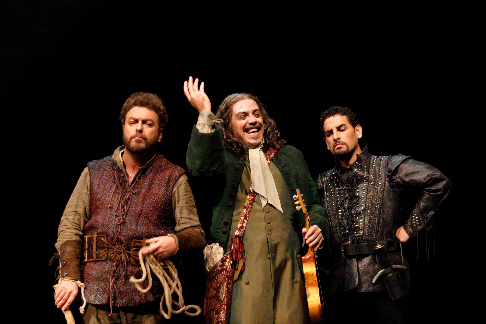 Carlo Lepore as Ginardo, Alfonso Antoniozzi as Isidoro and Juan Diego Flórez as Corradino [Photo by Catherine Ashmore courtesy of The Royal Opera House]
Carlo Lepore as Ginardo, Alfonso Antoniozzi as Isidoro and Juan Diego Flórez as Corradino [Photo by Catherine Ashmore courtesy of The Royal Opera House]
In the trouser-role of Edoardo, Vesselina Kasarova was disappointing, her top register sounding disjointed from the rest of her voice, though it's always a warm sound, and the reunion with father Raimondo (Mark Beesley) was very affecting – a serious sub-plot in an opera which is otherwise a sharp comedy. Alfonso Antoniozzi was endearing as the poet Isidoro, and those in the minor roles all contributed to a surprisingly well-integrated ensemble performance considering the opera's hybrid pedigree.
Mario Martone's production was constrained by Sergio Tramonti's austere set design, consisting of two enormous concentric spiral staircases snaking up into the flies, and a ramp leading up to an aperture at the back. Though it gave three dimensions to the movement on stage, it was excessively limiting, not to mention colourless. It was left to the principal singers to maintain interest throughout a long evening, a feat which they more than achieved with snappy assistance from Carlo Rizzi in the pit. But really – with this classy a vocal cast – it would have worked just as well as a concert.
Ruth Elleson © 2008
image=http://www.operatoday.com/Matilde_456.png image_description=Matilde di Shabran ROH 2008 [Photo by Catherine Ashmore] product=yes product_title=G. Rossini: Matilde di Shabran product_by=Aleksandra Kurzak (Matilde Di Shabran), Juan Diego Florez (Corradino), Mark Beesley (Raimondo), Vesselina Kasarova (Edoardo), Marco Vinco (Aliprando), Alfonso Antoniozzi (Isidoro), Enkelejda Shkosa (Contessa D'Arco), Carlo Lepore (Ginardo), Robert Anthony Gardiner (Egoldo), Bryan Secombe (Rodrigo). The Royal Opera. Carlo Rizzi, conductor. product_id=Above: Aleksandra Kurzak as Matilde di Shabran and Juan Diego Flórez as Corradino [Photo by Catherine Ashmore courtesy of The Royal Opera House]Hänsel und Gretel at the Royal Academy of Music
Neil Fisher [Times Online, 19 November 2008]
Something must be behind the sudden resurgence of Humperdinck’s opera, which has already had two major outings this year, from Welsh National Opera and Glyndebourne. Now Covent Garden are knee-deep in rehearsals for their new production, due early next month.
Hölderin, Staatsoper Unter den Linden, Berlin
By Shirley Apthorp [Financial Times, 18 November 2008]
Presumably there was no curse upon the Berlin Staatsoper, but there might as well have been one. When Peter Mussbach penned the libretto for Peter Ruzicka’s new opera, Hölderlin, the Intendant of the Berlin Staatsoper meant to stage it himself. Six months before the planned opening, political ructions led to Mussbach’s ousting.
Revisiting Rossini's 'L'italiana in Algeri'
By David Patrick Stearns [Philadelphia Inquirer, 18 November 2008]
The Opera Company of Philadelphia on Friday revived its lovable, storybook production of Rossini’s L’italiana in Algeri. It was first seen in 2000, both at the Academy of Music and on PBS, and was kept on ice presumably until a cast could be assembled that wouldn’t compare badly with the earlier one, which contained the then-up-and-coming Stephanie Blythe and Juan Diego Florez.
November 18, 2008
Doctor Atomic and Arjuna’s Dilemma
I thought of this during one of the many patches in John Adams’s new opera, Doctor Atomic, when nothing much was going on and there was plenty of time for gathering wool. But the particular buildup of suspense I reflected on was Mozart’s, in the Act I finale of his last opera, La Clemenza di Tito. Sesto (you may remember) has set fire to the Capitol and stabbed the emperor, his great friend, at the request of the snubbed Vitellia – who has changed her mind, but too late. The orchestra depicts the rising flames of the catastrophe, aided by the chorus. The chorus sings no words, only “Ah!,” a cry of horror, in various tones – we may, perhaps, assume their feelings are too shocked for words, or that the distance and the flames are turning their words into undifferentiated noise. In the foreground, Sesto is cursing himself for his hideous deed. If we have read the synopsis, we know that in fact he has slain the wrong man, and Emperor Titus is just fine (and will remain clement). No matter – the alarm of the crowd, the insanity of the act, the emotions of the evildoer occupy our thoughts. The music rises and falls, and we are at the edge of our seats: what will happen next?
There was very little suspense at Doctor Atomic. The bomb will be tested, it will be a success, the earth will not explode due to chain reaction, the bomb will then be dropped on Hiroshima, the war will end, the world will be shocked and uneasy. We all know that. It is up to the composer, the librettist (Peter Sellars), the director (Penny Woolcock), the conductor (Alan Gilbert), the singers to make us feel the tension of unanswered questions: what will happen next? To whom will things happen? (Because these characters stand in for us, who have been haunted by the bomb all our lives.)
They do not achieve this.
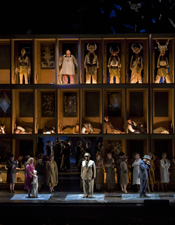 A scene from John Adams’s Doctor Atomic. [Photo by Ken Howard courtesy of Metropolitan Opera]
A scene from John Adams’s Doctor Atomic. [Photo by Ken Howard courtesy of Metropolitan Opera]
There is, in fact, a great deal of musical interest going on during
Doctor Atomic – in the pit. There are genuinely intriguing
sounds, developments, inspired innovations of percussion, melodies that spin
and writhe and tingle. As a symphonic meditation on nuclear energy and its
destructive implications, this would be an evening worth spending.
Adams’s purely instrumental music is often impressive, sometimes deeply
feeling. As the accompaniment for stage action and a work of vocal theater,
however, Doctor Atomic let me down.
The libretto was certainly at fault – it’s very difficult to create poetic, metaphorical feeling on the grandiose level on which this work pompously and preachily insists if the words you hear remain sullenly, risibly pedestrian. Bets on the amount of radiation. Nervous but hardly profound discussions of the implications of the weapon. Pros and cons of dieting. A sonnet by John Donne that might be a step in the right direction if it had anything to do with the action, and if the setting were at all appropriate or at least appealing. (How on earth can anyone make a New Mexico sky at sunset, or during a thunderstorm, dull?) A vision from the Bhagavad Gita and a lullaby by a Native American seem designed merely to cover extra cultural bases – and the lullaby, insistently chanted to keep us mindful of the coming catastrophe (well, Native American songs often are one or two lines, repeatedly chanted) does not build tension – it gives evidence that tension is what they creators of this work would like to provide. But, words and music, they have no idea how to go about it.
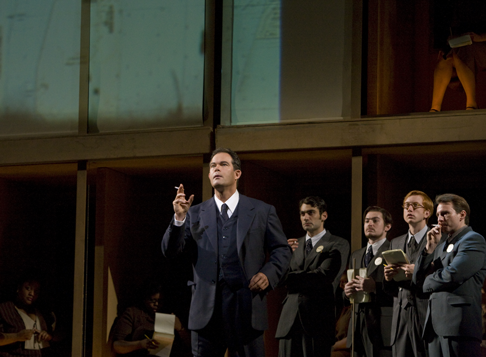 A scene from John Adams’s Doctor Atomic with Gerald Finley (center) as J. Robert Oppenheimer. [Photo by Ken Howard courtesy of Metropolitan Opera]
A scene from John Adams’s Doctor Atomic with Gerald Finley (center) as J. Robert Oppenheimer. [Photo by Ken Howard courtesy of Metropolitan Opera]
The voices are well produced, but they are deployed as electronic instruments might be: as notes on a page, not as instruments of emotional utility. Everyone in this opera is ordinary but no one is human. Even the gods of Wagner and Gluck get to be human. (I am told Gerard Finley’s personal agonizing, as Oppenheimer, was poignant on screen, but in the house, mediated by microphone, it made very little effect. Sasha Cook sounded good, but whether her character, Kitty Oppenheimer, was agonized by her marriage or the bomb or wondering what to pay the babysitter was not apparent from her vocalises.)
The staging is certainly at fault – like the libretto, it harps on the inanity of the human activity that led to such profound consequences, without illuminating either one. If you’re going to symbolize world-catastrophe, you have to make it personal, but Sellars and Adams cannot make their inventions live. They can’t even make them explode. Oh for a Mozart. No, there aren’t many Mozarts – oh for a Ponchielli or a Meyerbeer, journeymen who knew how the machine worked, how to put catastrophe on stage, how to make it personal and real to a large, disparate audience. How about a hunchbacked scientist who invents a bomb out of vendetta on his society and discovers too late that it has torn the skin off his own beloved daughter? That might be an opera. If you could find a Verdi to compose it.
Instead we get the Oppenheimers’ marital problems, a failure to communicate, though thanks to the sound system, heaven knows they are loud enough. This scientist represents this argument, that scientist represents another one, and none of them are either human or archetypal enough to be superhuman. Just cardboard. One could forgive that if their music was interesting, but the vocal lines are uniformly un.
At the Met last spring, Satyagraha, with its diorama staging and intentionally incomprehensible libretto (in Sanskrit), was a vocal drama of real excitement and beauty, with metaphorical actions giving access to the creators’ meditations on significant philosophical questions. There was no suspense in Doctor Atomic, and nothing in the debate around the atomic bomb was brought to life in it.
Arjuna’s Dilemma is another recent opera based, in part, on the text known as the Bhagavad Gita, the most famous (and philosophical) episode from the Mahabharata, the longest epic ever composed. With Satyagraha and Doctor Atomic, this is the third opera I’ve seen this year that drew on the Gita – which has become the Orlando Furioso of modern opera, as the Gita itself and its characters grow as familiar to opera-goers as Ariosto’s characters were to music lovers of Handel and Vivaldi’s day.
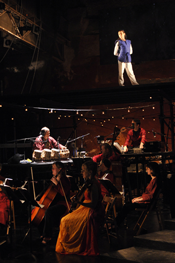 Badal Roy on tablas (foreground) and John Kelly as Krishna (center) from Arjuna’s Dilemma [Photo by Stephanie Berger]
Badal Roy on tablas (foreground) and John Kelly as Krishna (center) from Arjuna’s Dilemma [Photo by Stephanie Berger]
In the Gita, Prince Arjuna, driven (with his four brothers) from
their kingdom by some sneaky cousins, is about to take part in a murderous
battle with the usurpers, and has doubts about the whole thing –
killing, being killed, slaying all those pals he used to hang with, spreading
mayhem through the countryside and no doubt into the heart of many a widow
and orphan and bereft parent. What’s it all for? His
charioteer, however, assures him that life goes on (and everyone who dies
will be born again anyway), that he’s just one cog in the great big
wheel of life which will cease to turn if people stop to question their
proper position. Of course he’s no mere charioteer – he’s
none other than the god Krishna, and vouchsafes the prince a vision of the
universe as symbolized by his ineffable self. (This is the bit that
Oppenheimer saw in Doctor Atomic.) Arjuna, convinced and
enlightened, fights on. (Where was Krishna when Achilles had his far less
worthy doubts in the Iliad? – you may well wonder.)
Douglas Cuomo has turned the Gita into an opera, making use of amplified voices, Indian percussion, cellos, saxophones, a bass clarinet from the Western tradition, background film, foreground choreography, titles to translate the Sanskrit and English text, all the bells and whistles of modern opera-creation as deployed, also, by John Adams at the Met. The techno wonders are all here (in BAM’s self-consciously decrepit Harvey Theater, a credible scene of battle), and the grandeur of the presentation matches the grandeur of the conception.
But the experience of Arjuna’s Dilemma is a very different one from the experience at the Met. Partly this is a matter of length – Arjuna is about 70 minutes, no intermission – and partly this is a matter of lack of pretension. The story is a wisdom text not an action text, a central prescription for the life well-lived in Hindu terms, a revelation of the god, but one does not feel preached at, manipulated, in this work – and there is no attempt to tie the extraordinary to the mundane in the way that a troubled marriage and the quotidian concerns of the scientists totally failed to achieve in the gaudier piece.
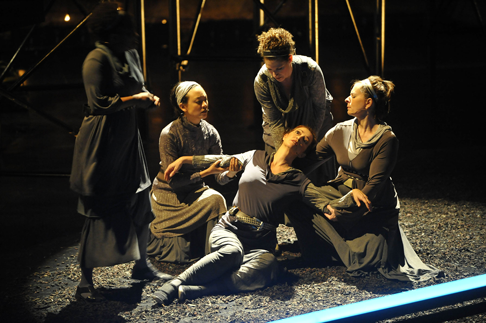 (l-r) Anita Johnson, Bora Yoon, Suzan Hanson, Kirsten Sollek, and Barbara Rearick from Arjuna’s Dilemma [Photo by Stephanie Berger]
(l-r) Anita Johnson, Bora Yoon, Suzan Hanson, Kirsten Sollek, and Barbara Rearick from Arjuna’s Dilemma [Photo by Stephanie Berger]
Most of all, Arjuna’s Dilemma has been created by a composer who trusts sound, a few fine voices and a few fine virtuoso instrumentalists, to reveal his message in the same way that the great opera composers trust the sounds will bring to us. The singers’ art (and the instrumentalists’ art) is the central focus of the work. The message is not made explicit and ordinary, humdrum, as Peter Sellars’s text did in Doctor Atomic; its meaning comes to us subtly, open to our different levels of understanding, on the beauty of the human voice, of melody working sinuously to take us into trance states while we meditate, line by line, on the brief story being told us. Tony Boutté impersonates Arjuna, dancer John Kelly (who has also choreographed the piece) plays – but Humayun Khan sings – Krishna, advising, consoling, manipulating, guiding him. Their words are taken up, repeated, sung in canon, tossed about, harmonized by a chorus of five women, and the beauty of the sounds they make expresses a message never made explicit. We draw our own moral. The instrumentalists, too, are virtuosos, and take part in the dialogue. No message goes on too long before it evolves into a new manner of presentation, giving us in this brief space some hint of the breadth of the message, the universality of it.
The piece concludes without a gimmick: they have said what they wanted to say, we have taken in what our individual senses and understanding have prepared us to take. A tale has been told. We have not been told what to feel. We feel for ourselves.
Arjuna’s Dilemma is a modern opera, a tale told through singing.
John Yohalem
image=http://www.operatoday.com/DOCTOR_ATOMIC_Cooke_Finley_.png image_description=Sasha Cooke as Kitty Oppenheimer and Gerald Finley as J. Robert Oppenheimer in John Adams's "Doctor Atomic." Photo: Ken Howard/Metropolitan Opera product=yes product_title=John Adams: Doctor AtomicJ. Robert Oppenheimer (Gerard Finley); Kitty Oppenheimer (Sasha Cooke); Teller (Richard Paul Fink); Wilson (Thomas Glenn); General Groves (Eric Owens); Hubbard (Earle Patriarco); Pasqualita (Meredity Arwady). The Metropolitan Opera. Conducted by Alan Gilbert.
Douglas Cuomo: Arjuna’s Dilemma
Arjuna (Tony Boutté); Krishna (John Kelly/Humayun Khan); Ensemble (Suzan Hanson, Anita Johnson, Barbara Rearick, Kirsten Sollek, Bora Yoon); Saxophone (Bob Franceschini); Tablas (Badal Roy). Conducted by Alan Johnson. Stage Director: Robin Guarino. Next Wave Festival, BAM Harvey Theater. product_by=Above: Sasha Cooke as Kitty Oppenheimer and Gerald Finley as J. Robert Oppenheimer in John Adams’s Doctor Atomic. [Photo by Ken Howard courtesy of Metropolitan Opera] product_id=
November 17, 2008
Opera in Germany
Juicy Three Oranges, a Dutchman that doesn’t fly and Boris in the boondocks
On the heels of Hitler, Germans, eager to be known again as the people of poets and thinkers — Dichter und Denker — flattered themselves with a joke. Give Germans the choice — it went — between going to Heaven and going to a lecture about Heaven, they would choose the latter.
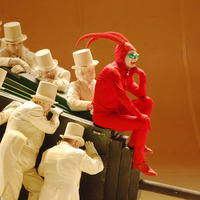 The joke wouldn’t get many laughs today — at least not in Berlin,
where the longest at the moment are neither for Heaven nor a lecture about
it, but for Madame Tussaud’s wax museum that recently opened on Unter den
Linden in the shadow of the Brandenburg Gate.
The joke wouldn’t get many laughs today — at least not in Berlin,
where the longest at the moment are neither for Heaven nor a lecture about
it, but for Madame Tussaud’s wax museum that recently opened on Unter den
Linden in the shadow of the Brandenburg Gate.
Nonetheless the ability of Germans to ferret out profundity astonishes. Take, for example, the production of Prokofiev’s Love for Three Oranges now on stage at the Komische Oper here. It’s an evening of fun and fluff welcome among stagings that leave one intellectually exhausted from trying to outguess directors who bring supposedly new insights to well-know works. But then turn to the KO program book and you’ll learn that Three Oranges is really an essay on the fate of theater in the still-young Soviet Union.
Prokofiev turned his back on the fruits of revolution in 1918. He wrote Oranges in Paris, and it was premiered in Chicago in 1921, when famed soprano Mary Garden ran the opera there. (“She was never around,” sighed Prokofiev. “She was off working on her own roles.”) It would thus seem to have little to do with Russia.
In 1917, however, Vsevelod Meyerhold, the great genius of Russian theater, had done a version of Carlo Gozzi’s commedia dell’arte L’amore delle tre melarance that provided Prokofiev with his libretto and led the composer to make of it an opera that took into account the demands that people made on the theater — and that the theater in a new society committed to the arts could reasonably make on them.
Knowing this brought depth, of course, to KO production, which, on the other hand, was a total success simply as joyous music theater very well done. Indeed, it’s not surprising that the KO is where Berliners go for an evening of great entertainment that does not perplex the mind.
This production, seen on October 26, further had a note of poignancy about it, for it is the brain child of KO general director Andreas Homoki, who is about to leave the company. Homoki has elevated the KO to the level of excellence that it knew under its founding director Walter Felsenstein, the man who laid the foundation of modern music theater in Germany after the war. It was Homoki who brought to the KO the quality and prestige that caused Opernwelt, Germany’s top opera magazine, to name the company “opera of the year” two seasons ago.
Leading roles in Oranges were sung by Finnur Bjornson (Prince), Carsten Sabrowski (King) and Aurelia Hajek and Renatus Mesá’s (Good and Bad Magicians, respectively). Stefan Blunier conducted an impressive orchestra. Meyerhold, by the way, gave up on his hopes for an artists’ paradise in the USSR and killed himself.
Karl Marx did not die along with the demise of Germany’s sometimes violent New Left in the late years of the past century; he’s just been hiding out in the wings of Berlin’s Deutsche Oper, secure in the knowledge that his day would come again. And with Capitalism teetering on the brink, it may indeed now have come.
Proving furthermore that the arts are ahead of politics, Marx’s resuscitation was anticipated by the production of Wagner’s Flying Dutchman that debuted in June at this largest of Berlin’s three opera houses. This is the work of Tatjana Gürbaca, yet another director rooted in the theatrical theories of Bert Brecht and his major disciple in the world of music theater Ruth Berghaus. Gürbaca saw what was coming and that left her no time for wind and waves — or for ships or even a suggestion thereof. She had weightier matters in mind.
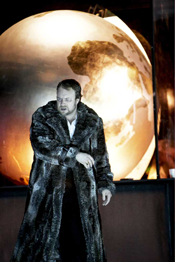 Johan Reuter as Fliegender Holländer [Photo by Matthias Horn]
Johan Reuter as Fliegender Holländer [Photo by Matthias Horn]
Act One plays in a rowdy room that combines bourse, bar and bordello.
Father Daland, a shipping tycoon and father of globalization is a capitalist
Everyman, ready in his commitment to the market to sell off his daughter
Senta to a tough-looking vagrant in bowler and beaver coat.
Things don’t look at all like Norway, and Gürbaca explains in the DO program book that this is Paris, a city that Wagner, on the heels of years of near-starvation there, wanted to see go up in flames because of its capitalist excesses. (In Wagner it’s always Götterdämmerung time somewhere.)
As the act ends Daland rushes off to tell Senta to get her make-up straight, while the unhappy Dutchman collapses in a chair. A chorus member hangs a “Just Married” sign — in English — on him. (Marx lived in England.) Even experienced Luddites would have a hard time figuring what is going on in Act Two, for there’s not a hint that spinning wheels have given way to power looms.
 Tatjana Gürbaca
Tatjana Gürbaca
One sees rather in a high-tech beauty emporium, where women — under
Capitalism always a chief (and cheap) commodity — are getting gussied up at
long tables with mirrors. Senta, of course, will have none of this. She’s
lost in her dreams about the dark Wanderer savable only through her
sacrifice.
Boy friend Erik, whom Senta did after all promise to marry, is more important to Gürbaca than to other directors, for whom he is only an unwelcome stumbling block to be brushed aside after some attractive lines for a budding — or aged — Heldentenor. But Erik is a hunter, a sweat-of-the-brow guy, a well-integrated member of an economic order not involved in the exploitation of others — unless, of course, you happen to be a wild boar. Erik is the real loser here, and — with Gürbaca — we’re all firmly on his side.
The finest moment in this act is when four giggling girls (the giggle is not in the score) push a baby buggy between Senta and the Dutchman in the middle of their big duet. (This is the kind of thing, Brecht would tell us, that makes people think.)
A literally bright moment in the final act — the DO Dutchman is played, as Wagner wished, without intermission — comes when Senta’s bridal veil is burned in the baby carriage. One might as well have fun with the buggy — and the veil, for Senta will have no need for either. After slitting Erik’s throat (“Remember Erik?” Anna Russell might ask), she cuts her own jugular, and the rest of the women do likewise. (Pity perhaps, on the other hand the libretto had earlier speculated — oh suggestive line! — that all these virile he-men seemed not to need women.)
Gürbaca is an obviously bright woman, and one wishes that Alan Greenspan had read the brilliant essays in the DO program book before applauding Dubya’s economic policies. One wishes that what she had in mind with this production worked.
Alas, it doesn’t. It doesn’t work at all, and word about that has gotten around Berlin, for you could have hunted deer in the first balcony on October 25, when the house was half empty. That was a shame, for musically it was a superb evening.
Johan Reuter is austere and awesome Dutchman, and Manuela Uhl, although obvious hired at the end of the opera, an attractive and impressive Senta. Hefty Torsten Kerl — Erik — might well be the next great Heldentenor, and Reinhard Hagen earns high marks as Daland.
Daniel Klagner conducted an ensemble that ranks high in a city that suffers from an excess of great orchestras.
Magdeburg, a city of half a million an easy two-hour train ride from Berlin, all but disappeared from Western sight during its 40 years as an East-German industrial center. Today Magdeburg is eager to attract attention, and a major draw of the city is its ultra-modern 700-seat theater that opened in 1995.
In the States one would expect this to be the venue of a regional company performing three or four operas a year. For the current season Oper Magdeburg has slated five new productions — along with a dozen works already in the repertory.
Of special interest is the company’s staging of Mussorgsky’s original 1869 version of Boris Godounov that premiered on October 24. As the composer intended it, Boris is a straightforward, heavily dramatic work without the glitter and glamour added by Rimsky-Korsakov in the version more popular today.
Magdeburg brought the opera up to date with a modern-dress staging that opened with a 120-voice voice choir lining the sides of the auditorium while Nikitisch, a government official with a strong resemblance to an about-to-be American ex-president manipulated the election of a new czar.
Nikolaus Meer, with a white mane that makes him a Horostovsky look-alike, sang a strong and sympathetic Boris, bringing both beauty and pathos to the opening coronation and the later mad scene. The many supporting roles were well executed in a production marked by careful preparation and close attention to details by Vera Nemirova, a director whose work is respected and Vienna and is about to stage a new Ring in Frankfurt.
Magdeburg music director Francesco Corti conducted an astonishingly impressive orchestra that performs a full season of symphonic concerts as well. A bust in the foyer recalls that early in his career Wagner was Magdeburg’s music director.
Opera Magdeburg is clearly making its mark.
Virtuoso vocalists
In mid-October two of today’s finest singers — Americans both — appeared as soloists with Berlin’s top orchestras in the city’s famous and acoustically perfect Philharmonie: Deborah Polaski and Kelley O’Connor. With the Berliner Staatskapelle and its music director Daniel Barenboim Polaski, for almost two decades the leading incarnation of Wagner’s most dramatic female figures, sang Arnold Schoenberg’s Six Orchestral Songs, Op. 8.
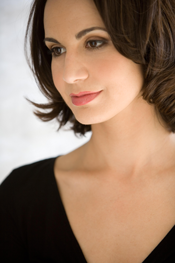 Kelley O’Connor
Kelley O’Connor
Completed in 1805, before his embrace of atonality, these are the first
songs, in which Schoenberg turned from piano to orchestral accompaniment.
They further embrace an expressive range that reaches from the late
Romanticism of Wagner and Strauss of the opening Natur to the more
advanced idiom of the three Petrarch texts that conclude the cycle.
Polaski, who between 1988 and 1998, sang more Brünnhilde’s at the Bayreuth Festival than any other singer since World War Two, is a commanding presence in the concert hall. She delivered the rarely heard songs with full appreciation of their shifting style, benefiting of course from her long collaboration with Barenboim.
It is impossible to put aside sentiment in hearing Peter Lieberson’s five Neruda Songs, for they stand today as the composer’s superb creative act of homage to his late wife Lorraine Hunt. The soprano premiered the songs, a declaration of love that reaches beyond the intimately personal to a universal celebration of this most problematic of human entanglements.
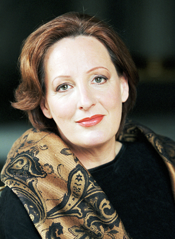 Deborah Polaski
Deborah Polaski
Lieberson discovered the 100 sonnets by Pablo Neruda shortly after meeting
Hunt in 1997. She premiered them in 2005 — and died of cancer the following
year. Although it might seem an act of trespassing for another vocalist to
sing the songs, with her gentle and modest humanity Kelley O’Connor, now
the leading interpreter of them, magnifies the act of homage that they
originally were.
She sang them last summer at the Aspen Festival with Lieberson in the audience and has repeated them since with the Chicago Symphony under Bernard Haitink, who — due to illness — was replaced on the podium of the Berlin Philharmonic by David Zinman, who had conducted the Aspen performance.
Although one hardly thinks of any singer as closely associated with Spanish music, O’Connor launched her career by creating the role of Federico Garcia Lorca in Osvaldo Golojov’s Ainadamar at Tanglewood in 2003 and then repeating this role around the world in the composer’s later expansion of the work.
O’Connor has a thrillingly rich lower register that is especially well suited to the haunting spirit of both Neruda’s verse and Lieberson’s setting of it, for an anticipation of death is present in both.
Berlin takes Onegin out of the birches
Stravinsky called Eugene Onegin the “most Russian” of Tchaikovsky’s operas, and scholar Vissarion Belinsky viewed the 1879 work as “an encyclopedia of Russian life.” Achim Freyer, director of the Onegin currently on stage at Berlin’s Staatsoper, does not share these opinions. In an essay in the company’s program book he insists that “today St. Petersburg is everywhere” and that this story could now be set in Dubai , out in the country or in Berlin with equal validity. Not everyone agrees, and the current Onegin that — new in September — was the Staatsoper’s major contribution to the 2008 Berlin fall festival, has given rise to a controversy that recalls the 1913 Paris premiere of Stravinsky’s “Rite of Spring.”.
On October 22, however, when the production was on stage for the seventh time this season, no one left the packed hall until uniform applause had declared Freyer’s concept a success. And it was a fine final touch that Daniel Barenboim, the evening’s conductor and music director of the Staatsoper, brought the entire Staatskapelle, his pit band, to the stage to share this approval.
Over-the-top opera productions are the norm in Germany, the land of Regieoper that puts the director totally in charge. Nonetheless Freyer had a hard act to follow in the Onegin new at Munich’s Bavarian State Opera last season. With thoughts of “Brokeback Mountain” obviously in mind Polish director Krzystof Warlikowski, a former assistant of Peter Brook, moved Tchaikovsky’s Russians to the American West. And, viewing the work primarily as the composer’s confrontation with his own homosexuality, Warlikowski focused attention on the close relationship between Onegin and his friend Lensky. (“Close?” Close indeed, for at one point Warlikowski had them in bed together.)
Freyer, about to launch the first “Ring des Nibelungrn” native to Los Angeles, goes in quite another direction. (Long in the wings, Luc Bondy had once been engaged to direct the Los Angeles Opera project.) For Freyer Onegin is rather a summation of the sentiments, sensations and — above all — the melancholy that were the heritage of the 19th century both in Russia and beyond. The director writes of that world as one of “loneliness, longing and boredom, of renunciation and rationality…but always with the hope of love fulfilled as its driving force.” Freyer, now 74 and once a Berlin student of Bert Brecht at his epoch-making (East) Berlin Ensemble, brings the hand of his teacher to rest on Onegin and his age.
Tchaikovsky called Onegin not an opera, but a series of “lyric scenes,” and Freyer treats it as a scenic oratorio. The entire cast is almost always present on a sharply raked empty stage; each stands alone, and they all face the audience. There is no direct exchange between them. Their loneliness and isolation cries out. Occasional wooden chairs — sometimes suspended in the air — are the only props. Costumes suggesting current dress are soiled white, and grease-painted faces are white with exaggerated facial features. Taking a cue perhaps from the slow-motion choreography of Robert Wilson, characters stay almost entirely in one place, restricting motion to arm and hand gestures.
The art of mime is heavily involved, and as Lensky Rolando Villazon is a Marcel Marceau look-alike. Huge eyes recall the once overly popular paintings by Margaret Keane.
Americans, inexperienced in such experimentation, would have a difficult time with this “Onegin.” Brecht, however, would have loved it, for it is a masterpiece of his theater of alienation, in which Freyer has opened a critical distance between stage and audience to fight what Brecht called the “culinary” theater of illusion that draws the spectator into the drama on stage. This is theater for the thinking man out to change the world.
Central to this approach is the primacy of the text, which makes clear that — despite the title — it’s Tatiana who is the central figure of “Onegin.” And in Anna Samuli, who in four seasons with the Staatsoper has made Violetta and Donna Anna signature roles, Freyer has a near-ideal Tatiana, youthful, but with a voice that despite its power made what Onegin calls her “chaste love” credible. Samuli was Barenboim’s Tatiana when he conducted Onegin with the Vienna Philharmonic at the Salzburg Festival in2007.
Things were complicated at the October 22 performance, when Villazon, slated to sing Lensky, was ill. He appeared before the performance, explained the situation in impeccable German and announced that Serghei Khomov would sing the role from the side of the stage, while he participated as actor only. (The illusion of a singing Villazon would have benefited from lip-singing on the tenor’s part.)
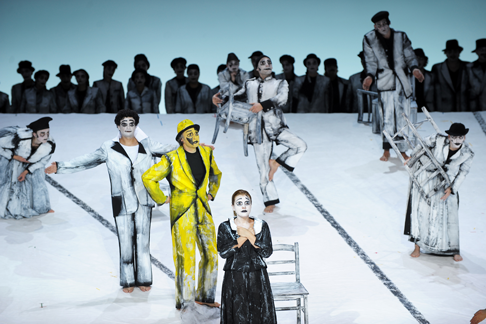 A scene from Eugene Onegin [Photo by Monika Rittershaus]
A scene from Eugene Onegin [Photo by Monika Rittershaus]
Roman Trekel, the Staatsoper’s leading bass when René’ Pape is not in town, is an elegant and appropriately aristocratic Onegin who does not overplay his hand either in refusing Tatiana’s offer of love or in his outcry “Oh, my miserable fate!” that ends the drama.
It is, of course, Barenboim who made the production work. He understands Freyer’s intentions and supports the director fully in making this an evening of overwhelming music drama. Given the intensity of the staging it would be senseless to interrupt its impact with actual dancing of either the famous first-act Waltz or the spirited Polonaise that opens Act Three. Indeed, on the heels of the duel that leaves a red-bathed Lenski still standing at the rear of the stage Barenboim plunges from the duel into the Polonaise with a fury that brings the drama to a head. Lensky’s then collapses, the source of a lake of black blood then covers the entire stage. (To achieve the effect the off-white fabric that had covered the entire stage is slowly withdrawn. It’s hard to describe, but the effect is tremendous.)
The first reaction is, that although interesting, one would not want to see this Onegin again. But one gets up the next morning thinking of nothing else and wishing it were on stage again that night.
Freyer is his own designer.
Onegin was sung in Russian with German surtitles.
As a footnote, a shot of cultural sociology: I have lived in Berlin for long periods since 1954 and thus knew the city — and the Staatsoper before the Wall went up in 1961. And during the almost four decades that the Wall stood, I spent extended periods in East Berlin as an exchange scholar. What amazes me today — as the city prepares to commemorate the 20th anniversary of the fall of the Wall — is how divided Berlin remains and how obvious this is at musical events in the former East.
In the past two years I have been here at Easter, when Simon Rattle and his “sacred cow” Philharmonic are off in Salzburg, performing for an international audience at the spring festival founded there by Herbert von Karajan. Thus Easter finds the Philharmonic’s Berlin hall free, and Barenboim and his Staatskapelle seize the opportunity to show their stuff with the Berliner Festage, a spring festival founded by the East decades ago to counter the appeal of West Berlin’s September Festwochen.
The Festage draw their own international audience. (It was during this spring festival that two years ago I heard the Mahler cycle for which Barenboim and Pierre Boulez shared the Staatskapelle podium. I mention this here because the cycle comes to Carnegie Hall in the spring.)
But I digress.
The Easter festival brings an international audience to Berlin; “Onegin,” as I saw it at the Staatsoper on an inauspicious Wednesday in October fills the historic house largely with subscription holders, and I was amazed at the ease with which I can still distinguish “Ossis” from “Wessis” — to use the categories now long common here — in this audience. One sees it in their clothes; one sees it in the women’s frizzy permanents, but above all one sees it in their behavior. Opera remains for them something special — as they were taught that it was by the former Communist government that kept top-priced tickets at the Staatsoper at 15 marks East — totaling around $1.00 at the then rate of exchange — for forty years.
This is their night out, and subscriptions continue to make the Staatsoper and its orchestra somewhat affordable. A season ticket for the eight concerts by the Staatskapelle are available at Euros 118 with the unusually strong dollar bringing up to Euro .74. And — happy day! — the Staatsoper is flooded by youth, where the East-West divide is far less evident.
All this makes a run-of-the mill evening at the Staatsoper something to be studied. Drop down to the buffet; enjoy a glass or Rottka”ppchen champagne — one of the few Eastern products to survive reunification — and study this show-within-a-show! Finally: three years “in exile” are coming up for the Staatsoper. Its house — it’s still essentially the structure built by Friedrich the Great that opened in 1742 — has been destroyed and rebuilt numerous times during Germany’s turbulent history and is now slated for badly needed total reconstruction.
What is to be done with the house is locally the subject of heated debate with one party calling for the construction of a hyper-modern auditorium within its historic walls. What visitors to Berlin need to know is that, beginning in the fall of 2009 and continuing for the next three years, the Staatsoper will be at home in the Schiller Theater, a modern venue once the pride of West Berlin and largely unused since Berlin has again been one city.
Wes Blomster
image=http://www.operatoday.com/Boris_Magdeburg.png image_description=Boris Godunow at Magdeburg product=yes product_title=Opera in Germany product_by=Love for Three Oranges, Eugene Onegin, Boris Godunow, Neruda Songs product_id=Above: A Scene from Boris Godunow at MagdeburgLa Damnation de Faust at the MET
There are excellent reasons for this reluctance. Berlioz’s magical setting of scenes from Part I of Goethe’s Faust (in de Nerval’s translation, also the basis for Gounod’s opera) focuses hardly at all on the scenes of action that might be cobbled into a stage drama, but almost entirely on the poetic “background” of peasants dancing, students drinking, soldiers marching, fairies flying, devils cavorting, lords a-leaping, maids a-milking. This scene-setting and the fascinating and novel effects Berlioz drew from orchestra and chorus to depict it make up most of the evening, and traditional opera houses, even those equipped with elaborate stage machinery and full corps de ballet, seldom find it worth the effort. If you know Damnation at all, from live performance, it is probably from the concert hall, where the march and the sylphs are favorite show-off numbers, and two of its arias are greatly loved, Marguerite’s “D’amour, l’ardente flamme” and Méphistophélès’s serenade. Damnation fares a poor fourth in dramatic success as an operatic Faust, to works of Gounod, Boito and Busoni – but as a concert piece, it is rather better known than Schumann’s even less stageable Scenes from Faust. (Louis Spohr also composed a Faust, even before Goethe published his poem; one wonders what it can be like.)
As a masterpiece unwieldy by traditional means, Damnation is just the sort of opera the Met, with its spectacular stage and newly upgraded technical pizzazz ought to be putting on, rather than twisted interpretations of operas that worked just fine the old way, such as Peter Grimes, Lucia or (for that matter) Gounod’s Faust. And now the Met has done it, and done it to a turn, in a staging by Robert Lepage (of Cirque de Soleil fame, not irrelevantly), aided by “software artist” Holger Förterer.
The enormous stage is subdivided into fifteen boxes that become alleys in a library, rooms in a tavern, a moonlit bridge over a river (and the depths of that river, and Faust swimming under water), the windows of Marguerite’s house (no rural cottage for this kid, but the street-long palace of the Hohenzollerns), the stained glass windows of a church (with five naked crucifixions) and, at last, the fiery pits of Hell, filled with naked choristers. Nor are three dimensions enough for this production – red-coated demonic lizards crawl about on the surface of it, defying gravity, and soldiers march from stage bottom to top, perpendicular to the wall, before falling, wounded, three stories, into the arms of lamenting sweethearts. Marcello Giordani has to climb a ladder down from the top of the stage (four stories or so) at the evening’s beginning, when Faust is an old man, not yet satanically rejuvenated, and Susan Graham must climb up it at the end, to reach salvation. (No one ever said that route was easy.) The long musical or choral interludes between Damnation’s few action scenes are danced or acted or mimed by enormous non-singing forces (and also the Met chorus, which has seldom had so much to accomplish, while singing to boot), to so busy an extent that I found it, while thrilling, a sometimes unfortunate distraction from the luxurious musical performance Donald Palumbo’s chorus and James Levine’s orchestra were giving to Berlioz’s constantly fascinating concoctions.
While a very young crowd, accustomed to MTV style in which every note has its accompanying video image (and to never shutting their eyes and letting the music make its own image in your head), may be entranced by this production, especially when it comes to movie theaters, there may be too much of a muchness for old-fashioned movie lovers who would like to revel in sheer Berlioz. That curdled opinion only came to me two or three times, but I found little difficulty concentrating on the evening’s musical delights when they were set before me.
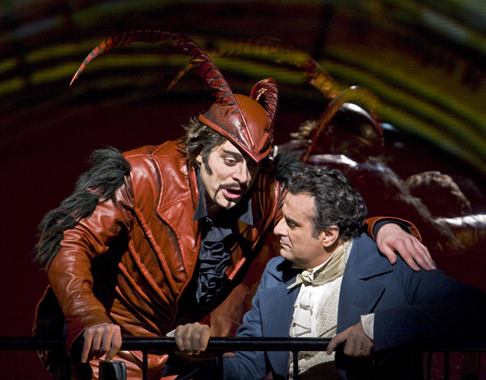 John Relyea (left) as Mephistopheles and Marcello Giordani as Faust
John Relyea (left) as Mephistopheles and Marcello Giordani as Faust
These musical honors, once the dancers, acrobats, and circus and lighting technicians had all been squared away, were neatly shared. Susan Graham may not be the most sensuous of mezzos – what would “D’amour, l’ardente flamme” have been like with Troyanos’s throb in her voice? – but it was splendid to have her back in her element rather than, as her Donna Elvira demonstrated, out of it: she sings Marguerite with total assurance, and fills the hall with the aria’s yearning message. John Relyea, who is obliged to do many athletic tricks in this production (but then, he flew at his debut, in Cenerentola, and mounted and rode a horse in Rodelinda), has a sizable if gruff instrument in which Méphistophélès’s wit and slimy charm if not his malice were always evident. He can win hearts by tossing a feathery leather cap, which he does at every opportunity. The only less than excellent work came from Marcello Giordani, who has made a specialty of heroic French roles (Raoul, Cellini, Enée), but here took half the evening to steady his voice, and was obliged to slide into falsetto once or twice for Faust’s punishing tessitura.
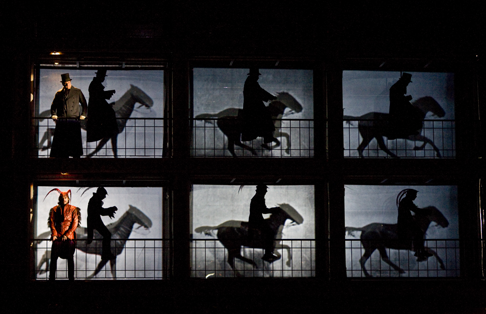 A scene from Part IV of Berlioz's "La Damnation de Faust" with Marcello Giordani in the title role (top) and John Relyea as Mephistopheles (bottom, in red)
A scene from Part IV of Berlioz's "La Damnation de Faust" with Marcello Giordani in the title role (top) and John Relyea as Mephistopheles (bottom, in red)
The stars, however, were James Levine and the orchestra that he has honed to diamond fineness, tricking out every brilliant detail and glow of Berlioz’s matchless ingenuity, giving us sensual pleasure to survive any distraction. The acrobats and the special effects were a treat, but I don’t think I’m the only one who found the evening’s real delight in the score itself, given such a performance.
This, surely, is as it should be.
John Yohalem
image=http://www.operatoday.com/Damnation_Faust_Met_01.png image_description=Susan Graham as Marguerie and Marcello Giordani in the title role of Berlioz's "La Damnation de Faust." [Photo by Ken Howard/Metropolitan Opera] product=yes product_title=Hector Berlioz: La Damnation de Faust product_by=Marguerite (Susan Graham); Faust (Marcello Giordani); Mephistopheles (John Relyea); Brander (Patrick Carfizzi).The Metropolitan Opera. Conducted by James Levine. product_id=Above: Susan Graham as Marguerie and Marcello GiordaniAll photos by Ken Howard/Metropolitan Opera
Alarm over music academy spreads
By Robin Usher [The Age, 18 November 2008]
THE protest against the Federal Government’s decision to close the Australian National Academy of Music at the end of next month has taken on an international dimension.
'Porgy' at last
By Andrew Patner [Chicago Sun-Times, 17 November 2008]
Chicago — one of the great music cities, great African-American cities and great Jewish-American cities — has waited a long time for its major opera company to produce the great American opera, “Porgy and Bess.”
Opera singing a new tune
By Graydon Royce [Minneapolis Star Tribune, 17 November 2008]
The Minnesota Opera will commit $5.5 million over seven years to contemporary repertoire under a new program just announced. Minnesota OperaWorks envisions three commissions, three revivals of American works and an international co-production.
Farewell act of chutzpah
By Andrew Clark [Financial Times, 16 November 2008]
The news that Gerard Mortier, the controversial Belgian impresario, will not be moving to New York City Opera has surprised no one. It was always a stretch to imagine a man so accustomed to the largesse of the state answering to a board of private individuals on whose generosity his every artistic decision would depend. Mortier remains at the Paris Opéra, but only till the end of the season: under French law state employees retire at 65.
The Devil Is in the Details
By Justin Davidson [NY Magazine, 16 November 2008]
With all the mergers reshaping our society, the marriage of opera and movies may seem like a secondary kind of fusion, but it may become permanent and profound. With its live broadcasts, the Met has a new toehold in the multiplex; now, Robert Lepage’s multimedia production of Hector Berlioz’s La Damnation de Faust has resoundingly imported cinematic imagination into the opera house.
'Figaro' at Music Hall one of best Dallas Opera productions in memory
By Scott Cantrell [The Dallas Morning News, 15 November 2008]
The decors and dress are 18th-century, but the Marriage of Figaro that opened Friday at Fair Park Music Hall is as lively, as au courant, as a first-class TV sitcom.
The Greek Passion, Zurich Opera
By Shirley Apthorp [Financial Times, 12 November 2008]
Well-fed and well-off, these Christians pray to a God of compassion. But when refugees arrive on their doorstep, they turn their backs. Bohuslav Martinu’s The Greek Passion is an essay in hypocrisy.
November 16, 2008
La Traviata at the MET
That was the point of making the story into an opera in the first place. Serious, tragic operas were not, in those days, set in contemporary times, or among bourgeois persons. The management of La Fenice was sufficiently nervous to backdate the sets and costumes by a hundred years to the era of Manon Lescaut, but no one was fooled – everyone knew about Dumas’s recent, somewhat autobiographical hit novel and play, La Dame aux Camellias.
But more: La Traviata, for all its denunciation of hypocritical society, underlined a moral: once a woman had been around the block, she could never go home again, make a successful marriage, live happily ever after, become somebody’s mother, for heaven’s sake! It was important that this moral be made clear because, even back in 1853, everyone knew it wasn’t true – women of dubious reputation made prominent, respectable marriages all the time – even in Italy, never mind Paris. (For men with a past, of course, there had never been a problem.) In Italy, where divorce would not be an easy matter for another hundred years, marriages ended and divorced persons made alternative arrangements, accepted by their friends and families with greater or lesser indifference. Violetta simply had bad luck – and bad microbes. (Her original, Marie Duplessis, the high-class courtesan who discarded Dumas fils, wedded a nobleman but died of consumption at 23.)
The Met’s overcrowded Traviata has been touched up, polished and primed because Act II was telecast as part of the opening night Gala – but also to give a little more clarity to some of the muddier moments of the overblown Zeffirelli staging. There is a new conductor, Paolo Carignani, who leads a taut, lean performance without skimping on necessary sentiment – a waltz is a waltz is a waltz. His tempos are a bit frenetic in Act I – the singers seemed to find them too fast as well – but throughout the evening the climaxes evolved naturally from what had gone before, and no one was drowned out.
Anja Harteros is a tall, slim, handsome lady of aristocratic mien, appropriate to the Countess in Figaro, the role of her Met debut. In the party scene, where a tiara perches atop her dark curls, she resembles some frozen, forbidding royal of World War I vintage, which did not make for a sympathetic figure. I’d have liked her a lot more without the sparkles up top.
Her voice, when not warmed up, is harsh, even acid. In Act I she was not at all appealing, coloratura uneven, pitch sometimes off target, and her top capable of no optional high notes. She was not, in this scene, a Violetta, and it was unclear what role would be suitable – Lady Macbeth perhaps, where a large, ugly sound and uneven coloratura are excusable. But by Act II, she had calmed down – or the conductor was not pushing her so hard – and she made rich, creamy sounds, especially at “Più non esiste – or amo Alfredo” (an exquisite moment, and one that usually goes by unremarked). Her “Amami, Alfredo,” was capable but not demented – she is entirely too collected to play a woman losing emotional control. The last act was her best. The voice then revealed a sweetness when singing softly – it is the brilliance of the first act that escapes her, that hardens her sound.
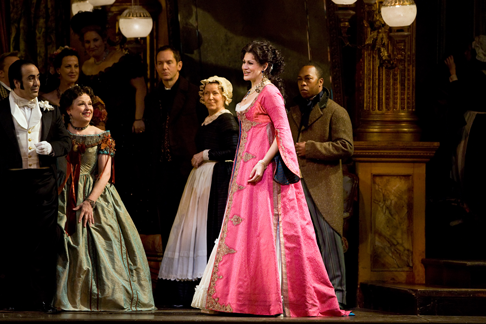 A scene from Verdi's "La Traviata" with Anja Harteros as Violetta.
A scene from Verdi's "La Traviata" with Anja Harteros as Violetta.
At least her height means she is one Violetta who does not look absurd beside the inevitable Baron Douphol of seven-foot-tall John Hancock, who has sung the part 36 times since this production premiered. Among other novelties this year: at curtain rise, he and Violetta were on the stairs, preparing to retire for a night’s romp, when their rowdy friends burst in, to his manifest annoyance. There is less picnicking on cushions in the opening scene than there used to be. But I miss the glove of challenge Hancock originally threw down to Alfredo at the end of Act II – the music expresses it, the era demands it, why has the Met deleted it? Do they think modern audiences would laugh? Would they? Would it matter?
The evening’s Alfredo, Massimo Giordano, is short, stocky, and not very handsome in the long “romantic” hairpiece that looked so good on Jonas Kaufmann. Giordano does not possess an instrument of exceptional beauty, but his instincts are musical; he does not bray and his high notes fill the room. He pays attention to the filigree in his cabaletta, and he launches himself into impassioned phrases with a nice sense of line. His finest moment – and Harteros’s – came during “Parigi, o cara,” sung caressingly, filling the house softly and accompanied tenderly – for a few minutes they were the perfect Alfredo and Violetta, singing to comfort each other, and we happened to overhear – a lovely bit of intimacy in this outsize occasion. (Harteros could use this voice for Lady M’s sleepwalk.)
Germont was Željko Lučić, who sang Macbeth last season: a real Verdi baritone, with a smooth, mellow sound as large as you could desire, and an actor’s judgment of the effect of each word. Most Germonts either stand stiffly or become excessively, even tearfully, sympathetic to the lady with a past whom they encounter in Act II; Lučić’s body language showed a provincial’s discomfort in this sophisticated milieu, and he had the grace to seem downright embarrassed at the sordid sacrifice he requested of her. A bit of a sob frilled each line of the second verse of “Di Provenza,” and I thought for a moment they might not cut his cabaletta. Cut it they did; the number is a pointless convenienze, but for once I wanted to keep it in, just to continue reveling in his sound. Ever-reliable Theodora Hanslowe sang Flora and Kathryn Day sounded clear as a bell in the usually fade-out role of Annina.
With Lučić as the thane, Harteros as his lady, Giordano as Macduff and lively Maestro Carignani urging the witches on, a potentially great cast for Macbeth currently holds the stage in the Met’s Traviata.
John Yohalem
image=http://www.operatoday.com/TRAVIATA_Harteros_Giordano_.png image_description=Anja Harteros as Violetta and Massimo Giordano as Alfredo [Photo by Marty Sohl/Metropolitan Opera] product=yes product_title= product_by=Violetta: Anja Harteros; Flora: Theodora Hanslowe; Alfredo: Massimo Giordano; Giorgio Germont: Željko Lučić; Douphol: John Hancock; Annina: Kathryn Day. The Metropolitan Opera. Conducted by Paolo Carignani. product_id=Above: Anja Harteros as Violetta and Massimo Giordano as AlfredoAll photos by Marty Sohl/Metropolitan Opera.
Lucrezia Borgia at the Washington National Opera
My subject today is the first of these, Donizetti’s perpetually underperformed 1833 masterpiece Lucrezia Borgia. The next installment, to appear in a few days, will comment on the second – Bizet’s perennial favorite, the 1875 Carmen.
Lucrezia is a fiendishly difficult work for all involved. Spectacular settings of Renaissance Venice and Ferrara require the expensive kind of luxury in staging – luxury without ostentation. The director must create a sympathetic figure out of a legendary mass murderess, whose grit Donizetti evidently admired enough to make her a soprano, a victim, a mother, and a girl with a heart – most of the time… Meanwhile, the lead singer has to survive the endless bel canto lines and the head-spinning coloratura of her dramatic role written for a lyrical voice, all the while staying “in character” – and a character that psychologically is barely comprehensible to most of us. This was a tall order, and the result was worth the price of admission, which at the Washington National is always memorable in and of itself.
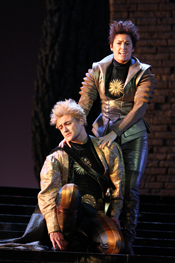 Vittorio Grigolo as Gennaro, Kate Aldrich as Maffio Orsini.
Vittorio Grigolo as Gennaro, Kate Aldrich as Maffio Orsini.
A major ingredient in the production’s success was the fact that it
was a Gesamtkunstwerk of sorts, with both stage direction and visual
design in the excellent hands of the admirable John Pascoe. The stunning
visuals, a fusion of old-world luxury with edgy and abstract modern lines,
were sophisticated yet not overbearing. Central to the design were gigantic
stone walls, first parting in welcome to the carnival atmosphere of Venice,
the endless party town, then closing ominously to lock the characters and the
audience in. Together with the fabulous lighting, a persistently excellent
WNO feature (designer Jeff Bruckerhoff), these sets enhanced the complex
psychological drama woven by Mr Pascoe the stage director. His reading of the
libretto explained (if not entirely justified) Lucrezia’s bloodthirsty
nature and reputation for promiscuity by casting her as a victim of incest
and sexual abuse – an interpretation for which there is a valid
historical precedent, as well as some veiled hints in the Donizetti score.
Just to top it off, the historical heroine’s fictional son, Gennaro, is
torn between an oedipal passion for his mother and a homoerotic one for his
best friend Orsini – it is almost hard to believe Lucrezia has
not yet joined The Tudors as a prime-time show on Cinemax!
Renée Fleming was billed as the star attraction of the show, and so she was. The singer’s famously buttery voice was on full display, even in Donizetti’s inhumane coloratura passages, which not only seemed easy, but were – a rare treat indeed – musical. Ms Fleming’s formidable acting skills served her best through the sections of the drama in which Lucrezia comes across as a sympathetic victim, fighting desperately for survival and the remaining shreds of her feminine dignity. It was harder to appear sympathetic in her Act 3 Scene 2 entrance, clad in male warrior attire (an unfortunate costume choice, in my opinion) and rejoicing in having just poisoned a group of admittedly foolish but basically harmless young men.
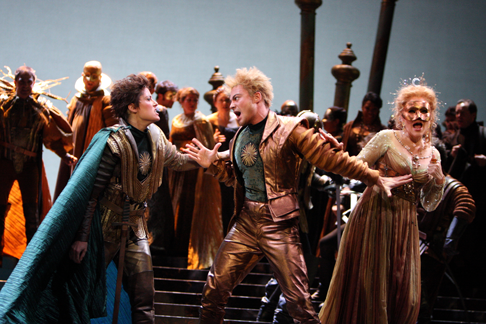 Kate Aldrich as Maffio Orsini, Vittorio Grigolo as Gennaro, Renée Fleming as Lucrezia Borgia
Kate Aldrich as Maffio Orsini, Vittorio Grigolo as Gennaro, Renée Fleming as Lucrezia Borgia
Vittorio Grigolo as Gennaro had an easier task. His character’s sexual ambiguity is defined situationally, in relation to others throughout the opera, while Gennaro himself essentially remains unchanged – a young, passionate, straightforward (if not totally straight) macho warrior. Mostly what is required to strike the right tenor here is, forgive the obvious pun, the right tenor. Mr Grigolo is in a possession of a fantastic one: sonorous, yet crisp and metallic, a highly appropriate timbre for Donizetti’s character. Despite his youth, the singer was a worthy partner to Ms Fleming. Then again, he started performing professionally at age thirteen, and his first solo gig was at the Sistine Chapel – not your average résumé!
Vittorio Grigolo was not the only young singer in the cast. He was partnered with mezzo-soprano Kate Aldrich in the travesti role of Maffio Orsini. One of the least experienced members of the ensemble, Miss Aldrich did an admirable job, which under normal circumstances would have garnered her well-deserved accolades. However, she was cursed by proximity. She simply could not quite hold her own in this all-star production and came across, undeservedly perhaps, as only adequate. On the other hand, the performance of the most venerable member of the line-up, the legendary Verdian bass-baritone Ruggero Raimondi, demonstrated both the advantages and pitfalls of experience. The 67-year-old singer appeared in a role with a significantly lower tessitura than those he performed in his early years. The part was shorn of most of its coloratura in an effort to accommodate the lack of flexibility in the voice, particularly conspicuous against Ms Fleming’s nonchalant virtuosity. Yet, unencumbered by the customary technical fireworks, Mr Raimondi was free to unleash his impressive dramatic talent, arguably more important than vocal prowess in the role of villainous Duke Alfonso. It was an honor to watch the old master at work.
Another master, Raimondi’s old partner Placido Domingo, was also involved in the production as the conductor of the performance. Unfortunately, on that front I have few laurel wreaths to award. Just as visual spectacle has consistently been one of the strongest elements of WNO’s productions, the company’s orchestra is almost always the weakest link. Donizetti’s score for Lucrezia Borgia is quite difficult for its time and genre; it contains, for instance, an unusual amount of brass writing, both in the pit and off-stage. Mr Domingo did a good job as a conductor, and the orchestra sounded better than the last time I heard it (in La traviata), but that is a very low bar to hurdle. In comparison with the level of artistry displayed by the singers and the director-designer in this production, the orchestral performance was barely passable, and I wish Mr Domingo, as the artistic director as well as conductor of the Washington National Opera could do something to improve a situation that surely cannot satisfy him. Other than that, Lucrezia is a world-class production, and the company is to be congratulated on its well-deserved success.
Olga Haldey
image=http://www.operatoday.com/2Fleming-as-Lucrezia_credit.png image_description=Renée Fleming as Lucrezia Borgia [Photo by Karin Cooper] product=yes product_title=G. Donizetti: Lucrezia Borgia product_by=Lucrezia Borgia (Renée Fleming), Gennaro (Vittorio Grigolo), Duke Alfonso (Ruggero Raimondi), Maffio Orsini (Kate Aldrich), Rustighello (Yingxi Zhang), Jeppo Liverotto (Jesus Hernandez), Apostolo Gazella (Grigory Soloviov), Ascanio Patrucci (Oleksandr Pushniak), Astolfo (David B. Morris), Gubetta (Robert Cantrell), Oloferno (Jose Ortega). Washington National Opera. Conductor: Plácido Domingo. Director: John Pascoe. product_id=Above: Renée Fleming as Lucrezia BorgiaAll photos by Karin Cooper courtesy of Washington National Opera.
Wozzeck, Munich
Michael Volle portrays Georg Buechner’s and Alban Berg’s character with unparalleled intensity, such a beautiful baritonal sound even in the most harrowing moments, and such ease beneath the tortured surface, that it is almost too good. He did everything as one could hope for in a Wozzeck on stage, but he never elicited much pity and never seemed quite as helpless-hapless as Wozzeck probably should. In a way, his great musical and dramatic strengths came at the expense of the character.
Something similar could be said about Andreas Kriegenburg’s direction – or more specifically the phenomenal lighting of Stefan Bolliger and how it works with the continuously fascinating set of Harald B. Thor and Andrea Schraad costumes: It is so absorbing, so good and stimulating to look at, it might distract from the psychological development of the characters. On Monday night, it also distracted from some so-so singing (Jürgen Müller underpowered and underwhelming as Drum Major and Clive Bayley with an average night as the Doctor) and in doing so, it unleashed the drama unto the audience in a visceral way that even Wozzeck-lovers might not have expected.
Because with this would-be quibbles taken care of, the fact remains that this was a stunning premiere, a spectacular performance, and indeed a striking success for the Munich Opera’s second new production under the new general director Klaus Bachler. Kriegenburg, a theater director, had done only two operas before (which I have not seen), but here he hit a nerve in just the right way. Instead of exerting a willful personality, ideology, or aching modernization on Wozzeck, he gives us an internalized picture (set roughly in the time of the play’s premiere) where the world as Wozzeck sees it is how the audience sees it. Except for Marie and his son, the characters are distortions of their personalities, one more disturbing than the next. The crowds are hordes of unemployed, shadows in the world of Wozzeck’s steadily slipping sense of reality. When the apartment-within-the-stage begins to very subtly shift left and right, the visualization of this losing grasp on reality becomes so perceptible, it’s as if you could touch it. I felt like I needed a splash of cold water or a slap in the face myself.
Amid this Michaela Schuster’s Marie altered between pleasurable cantabile and appropriate crudeness, Wolfgang Schmidt earned merits with his cleanly sung, morbidly obese captain, and Munich’s tenor-for-everything Kevin Conners delivered a fine, sonorous Andres. Wozzeck was also a good night – to the hesitant surprise of the Munich critics – for music director Kent Nagano.
Speculations about his contract not being renewed are only slowly residing, discussions about a rift between the music- and general director are still indulged in with tabloid-like diligence by the feuilletons. But this performance was one for a mark in his supporter's good books. Nagano’s strengths emerge best in modern works where clarity is part of the musical success.
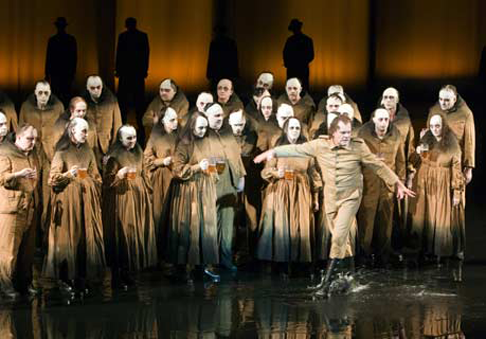
The orchestra, apparently well rehearsed, gave the music an elastic, clear treatment; the score sounded taut and diaphanous. Only very occasionally was the orchestra too loud; more often it was very sensitive. When Nagano waded onto stage, barefoot and his trousers rolled up, he received as warm a reception as I’ve heard him get in Munich. Only Kriegenburg and his team got more – wholly absent of boos, too, perhaps a novelty for a premiere of a modern production in Munich.
If any Wozzeck production can convince the hesitating masses to listen to this difficult 20th century masterpiece, it would have to be this one.
Jens F. Laurson
image=http://www.operatoday.com/rsys_26564_49180ae5e4158.png image_description=Scene from Wozzeck (Munich 2008) [Photo Wilfried Hoesl, courtesy Bayerische Staatsoper] product=yes product_title=Alban Berg: Wozzeck product_by=Michael Volle (Wozzeck), Michaela Schuster (Marie), Wolfgang Schmidt (Hauptmann), Clive Bayley (Doktor), Jürgen Müller (Tambourmajor), Kevin Conners (Andres), Christoph Stephinger (1.Handwerksbursche), Francesco Petrozzi, (2.Handwerksbursche), Kenneth Roberson (Narr), Heike Grötinger (Margret). Bavarian State Opera, Soloists, Bavarian State Opera Orchestra, Kent Nagano (conductor), Nationaltheater, Munich 10.11.2008. Andreas Kriegenburg (direction). Harald B. Thor (sets). Andrea Schraad (costumes). Stefan Bolliger (lighting). product_id=Above: Scene from Wozzeck [Photo by Wilfried Hoesl, courtesy of Bayerische Staatsoper]
PUCCINI: Madama Butterfly — Covent Garden 1957
Music composed by Giacomo Puccini. Libretto by Luigi Illica and Giuseppe Giacosa, based on the play Madame Butterfly by David Belasco.
First performance: 17 February 1904, La Scala, Milan.
Revised edition: 28 May 1904, Brescia.
Background:
Early in 1900, David Belasco, an American producer, needed a play with which to save a rather disastrous season, and finding possibilities in John Luther Long’s “Madame Butterfly,” he fashioned from it a drama in the short space of two weeks. His season was saved, for the play was a success, the all-night vigil making a particularly great appeal. Soon the play was produced in London, where the manager of Covent Garden saw it, and knowing that Puccini needed a successor to “La Tosca,” he wired him. Puccini came to London immediately, and was charmed with “Madame Butterfly” as an operatic possibility, even though, it is said, he did not at that time understand a word of English.
At its first performance the opera was a distinct failure. Perhaps the strangeness of a Japanese setting antagonized the audience; the second act, moreover, with its miniature all-night watch, so successful in the drama, became too long in the opera. The opera was withdrawn, Puccini made a few slight changes, and through necessity ruthlessly interrupted the vigil, making two parts of the second act. Produced three months later at Brescia, Madame Butterfly was a success, and since that day has become one of the most popular of operas.
While much of this success is due to the dramatically conceived play, much more is due to Puccini’s music. For the sake of local color the composer has introduced a number of genuine Japanese melodies—melodies that he was enabled to obtain exactly from Victor records made in Japan. Puccini also shows that he was aware of musical progress in the rest of the world, when, for instance, at the entrance of Butterfly, lie effectively makes extensive use of augmented triads after the fashion first brought into prominence by Debussy. In the more emotional parts of his opera, however, lie is thoroughly Italian and Puccinian in style.
| Principal Characters: | |
| Madame Butterfly (Cio-Cio-San) | Soprano |
| Suzuki, Cio-Cio-San’s servant | Mezzo-Soprano |
| B. F. Pinkerton, Lieutenant, U.S. Navy | Tenor |
| Kate Pinkerton, his American wife | Mezzo-Soprano |
| Sharpless, U.S. Consul at Nagasaki | Baritone |
| Goro, a marriage broker | Tenor |
| Prince Yamadori, suitor for Cio-Cio-San | Baritone |
| The Bonze, Cio-Cio San’s uncle | Bass |
Setting: Nagasaki, Japan, circa 1904.
Synopsis:
Act I
Scene—Exterior of Pinkerton’s House at Nagasaki
It is all vastly amusing! This matchbox of a house and its sliding panels, or shosi, in place of walls, neat and ingenious devices; and ridiculously inexpensive! Pinkerton, Lieutenant in the United Stales Navy, is charmed and amused as the self-important matrimonial agent, Goro, shows him over the little house he is to make his home during a not-too-prolonged stay in Japan. Presently Sharpless, United States Consul, turns up. Pinkerton tells him delightedly about the beautiful Japanese girl by whom he has been captivated, and whom he is to marry Japanese fashion for nine hundred and ninety-nine years, but with the privilege of annulling the marriage any month. The consul has a dim suspicion that the experiment may turn out more seriously than his friend anticipates, but Pinkerton will not listen to hints of tragedy. “Whisky?” proposes the Naval Lieutenant. Having filled their glasses the men drink to the toast “America forever!” then to the folks at home and to the time when Pinkerton will have a “real” wedding back in “God’s country.”
The two men stand looking out over the glorious scenery, so different from the homeland that to an American it is a make-believe world. From the foot of the hill girlish voices are heard, gradually drawing nearer. The music pulsates glowingly while the girls chatter about the beauty of the day and the flowers. Among them is Cio-Cio-San, “Madame Butterfly,” and to Pinkerton this little creature in her kimono is a butterfly indeed. Her voice soars above the others in broad, lyric phrases while she sings of the ecstasy of her love.
As the music reaches its climax the girls appear on the terrace and prostrate themselves before the “augustness” of Pinkerton. Sharpless enters into a conversation with Butterfly and learns that since the death of her father she has had to support herself and mother by becoming a Geisha.
The bride’s relatives, great numbers of them, now arrive. While the guests are all busied with the refreshments, Pinkerton amusedly watches Butterfly, who draws from her capacious sleeves her possessions . . . such trifles as handkerchiefs, a jar of carmine, a fan . . . and with great solemnity a long sheath. The officious Goro whispers an explanation to Pinkerton . . . the dagger was sent to her father by the Mikado . . . and he was obedient, Goro adds grimly. Thus is Pinkerton reminded that he is in the land given to seppuku, or “hara-kiri,” a condemned gentleman’s privilege to die by his own hand. Butterfly also shows him her ottoke, images of her forefathers; but she confides to Pinkerton that she has been to the Mission and adopted his religion, innocently adding that she will try to be frugal for she knows that he has paid for her the whole sum of a hundred yen. She declares that for his sake she is willing to forget race, kindred and ancestors; to prove this last, she throws away their images.
Goro commands silence and the quaint ceremony of signing the marriage contract takes place. The gaiety of congratulations is suddenly interrupted, for Cio-Cio-San’s uncle rushes in, violently enraged. Being a Bonze, or Japanese priest, he has learned that Butterfly has forsaken the faith of her ancestors upon marrying this foreigner. Therefore, he curses her with threats of eternal punishment, all her relatives likewise denounce her, for in deserting her gods she has likewise deserted her people! All rush away in horror leaving Butterfly weeping bitterly. Pinkerton consoles her, and in the thought of his love she is again happy. Night falls over the scene and they sing of their happiness together.
Act II
Scene—The Interior of Butterfly’s House
Part 1
Beyond the room one can see the garden with cherries in blossom, bright in the spring sunshine, but the wall panels being only partly open, the room remains in semi-darkness. Before an image of Buddha kneels Suzuki. Occasionally she rings a handbell while she prays that Butterfly’s weeping may be ended. Butterfly, who is standing motionless near a screen, tells her that the gods of Japan are lazy—her husband’s God will answer her more quickly. Although the money that Pinkerton left is almost gone. Butterfly is still so firm in her belief that her husband will return, that she commands the doubting Suzuki to say that he will. Suzuki complies in spite of her tears.
Greatly touched at this, Butterfly, to reassure herself as well as Suzuki, affirms her belief (in a famous aria), that some day (Un bel di) a great ship will appear far in the horizon . . . the boom of cannon will announce its arrival in the harbor . . . they will see him coming from a distance . . . climbing the hill. Butterfly will hide for a moment to tease him. . . he will call for her by the old names of endearment. . . so let fears be banished, Butterfly declares, utterly carried away by the joy of her anticipation, for he will return, she knows it!
At the moment she has finished this declaration of her trust, Sharpless appears. Goro, who has conducted him here, waits outside. “Madame Butterfly,” he calls. “Madame B. F. Pinkerton, beg pardon!” the wife corrects, then turning and recognizing her visitor, greets him cheerfully. He has a letter from Pinkerton, he tells her. She is the most happy of women, she replies, and then without waiting for Sharpless to read she asks him when the robins build their nests in America . . . for, she continues, Pinkerton had said that he would come back in the happy season when the robins return . . . now, for the third time the robins are building their nests. Sharpless, in his embarrassment, is forced to reply that he never studied ornithology. Goro laughs outright at this. The marriage-broker now presents Yamadori, a wealthy suitor, who, though he has had many consorts and divorced them all, says that he is madly in love with Butterfly and will swear eternal faithfulness to her. She repulses him and his proffered wealth, for she is married to an American, and in his country people remain faithful! Broker and suitor disposed of, Sharpless attempts to resume reading the letter; everything he reads is interpreted by Butterfly into some happy assurance that her husband will soon return. The consul has not the heart to go on, he asks Butterfly what she would do if Pinkerton were never to come back to her. As if struck by a death-blow Butterfly gravely replies that she might again become a Geisha or she might kill herself. Sharpless is horrified and advises her to marry Yamadori. This greatly insults Butterfly . . . ordering Suzuki to bring in “Trouble,” the name she has bestowed on her little son, she points to the child in agitated pride, and exclaims “And this? Can such as this be forgotten?” She asks Sharpless to write to her husband and tell him what a beautiful son he has. Thus does the consul learn to his surprise that unknown to Pinkerton there is a child. In true motherly joy, her attention concentrated entirely on little “Trouble,” she bids him not to believe the bad man when he says that father will not return, but leave them to wander through the streets for a living.
Sharpless leaves, fearful for the future. Soon after he has gone a cannon shot is heard booming from over the harbor, announcing the arrival of an American warship. With the help of a telescope Butterfly spells out its name—“Abraham Lincoln,” Pinkerton’s ship!
So, then, the agony of waiting is over! He has come with the robins—her lover, her husband, her adored one! In a moment the two women are feverishly rushing to the garden lo gather cherry blossoms to deck the house. They sing the joyous “Duet of the Flowers”, throbbing with the excitement and exultation of the rejoicing Butterfly, who then hastens to put on the wedding dress she wore on that day long ago, so that she may greet her lover as he first knew her. Little “Trouble,” too, is arrayed in his finest.
Night has been falling; the servant closes the shosi and brings in several Japanese lanterns which cast a dim glow over the darkened room. But they must await Pinkerton’s return . . . be ready to welcome him. In her anxious, joyful expectancy Butterfly has pierced three little holes through the wall so that they may watch for him. “Trouble” sits before one, supported by cushions; at another kneels Suzuki; close up against a third stands Butterfly, rigid and motionless . . . watching . . . waiting . . . A wonderful melody first heard during the reading of the letter, floats across the scene, softly hummed from a distance. “Trouble” soon nods, then falls asleep . . . next Suzuki . . . Butterfly keeps her vigil alone.
Part 2
The grey light of dawn begins to enter the room. Butterfly still stands, motionless, watching; Suzuki and “Trouble” still sleep, profoundly. The lanterns become even more dim while the day grows brighter; like the morning sunlight the music sparkles with vagrant Japanese melodies. Suzuki having awakened and begged her to lie down to rest awhile, Butterfly takes little “Trouble” and goes with him into an inner room. No sooner has she gone than Sharpless and Pinkerton arrive. Suzuki is overjoyed at seeing them, but they motion her to keep silent. She points out how Butterfly has decorated the house, and tells how she waited all night. The servant, on opening the shosi, exclaims in surprise for she notices a strange woman in the garden. Fearfully she asks who it is. Pinkerton’s wife, Sharpless explains. Suzuki cries out in grief.
Sharpless asks Suzuki to prepare Butterfly for this bitter revelation and tells her that the American woman has come to adopt the child. Pinkerton. overwhelmed with remorse, leaves the house after asking Sharpless to console Butterfly the best he can. A moment later Butterfly rushes in joyfully expecting to find Pinkerton. Instead she sees Sharpless, a foreign woman, and Suzuki in tears. She begins to realize the heartless truth. She asks if he is alive, her voice hushed with expectant fear. Only Suzuki’s broken “yes” is needed, and she knows that she has been deserted. Mrs. Pinkerton expresses her helpless sympathy, and asks to take the child. Butterfly, having listened in pathetic dignity, replies that only to Pinkerton will she yield her son . . . she will be ready in half an hour. Sharpless and Mrs. Pinkerton take their leave; Butterfly orders Suzuki to go into another room with the child.
Then she takes from its sheath the dagger with which her father had fulfilled the law of his people, and reads the inscription written upon its blade: “To die with honor when one can no longer live with honor.” She raises the knife to her throat. At that instant, the door opens and little “Trouble” runs to her with outstretched arms. She drops the knife, impetuously seizes the child and covers him with kisses. Having bade him a heart-rending farewell, she gives her son a doll and an American flag, urges him to play with them, then gently bandages his eyes. Again she takes the dagger, goes behind the screen. A moment later the blade is heard falling to the floor. Butterfly staggers forward groping her way to her child, takes its hand, and smiles feebly. She scarcely has strength to give her son one final embrace, then falls beside him, dead.
Pinkerton is heard calling her name. A moment later he rushes into the room followed by Sharpless. He kneels beside Butterfly sobbing with grief and shame; Sharpless takes the child and turns away.
The orchestra thunders out a solemn Japanese melody . . . over and above the very last note of that melody there sounds a poignant, questioning chord, as though this tragedy were not yet, nor ever would be, ended.
[Adapted from The Victrola Book of the Opera (Victor Talking Machine Company, 1929).]
Click here for the complete libretto, including alternate versions.